February 23 – March 12, 2025
Our final two days in Mexico we rode from San Cristobal to the border with Guatemala – and spent the rest of this segment riding through (most of) the “CA 4” – the “Central America 4”: Guatemala, El Salvador, Honduras & Nicaragua. Each of these countries had its own unique culture, customs & currency (except El Salvador which uses the USD). Along the way we were challenged by EXTREME heat & humidity yet encouraged by the locals generosity and welcoming.
- Day 280 – San Cristobal to Comitan – 90k/943m climbing
- Day 281 – Comitan to Camoja (Guatemala) – 95k/769m
- Day 282 – Camoja to Huehuetenango – 73k/1349m
- Day 283 – Huehuetenango to San Cristobal Totonicapan – 71k/1550m
- Day 284 – San Cristobal to Panajachel – 65k/1219m
- Day 285 – Layover @ Panajachel
- Day 286 – Panajachel to San Lucas Toliman by boat
- Day 287 – San Lucas Toliman to Esquintla – 94k/770m
- Day 288 – Esquintla to La Hachadura (El Salvador) – 107k/734m
- Day 289 – La Hachadura to Acajutla – 52k/236m
- Day 290 – Acajutla to El Zonte – 67k/731m
- Day 291 – El Zonte to Zacatecoluca – 72k/538m
- Day 292 – Zacatecoluca to San Miguel – 105k/479m
- Day 293 – San Miguel to Santa Rosa – 42k/477m
- Day 294 – Santa Rosa to San Lorenzo (Honduras) – 69k/478m
- Day 295 – San Lorenzo to Somotillo (Nicaragua) – 86k/551m
- Day 296 – Somotillo to Leon – 102k/462m
- Day 297 – Layover @ Leon
Total trip distance: 7,974 miles (12,838 km)
Total trip climbing: 364,552 feet
Countries: USA, Canada, Mexico, Guatemala, El Salvador, Honduras, Nicaragua
Number of flat tires: 20 (almost all caused by small wires from steel belting of tires)
On our way to Comitan, Mexico we began to see road signs for the “frontera” (border) with Guatemala – this was exciting and at the same time a wee bit stressful. This would be our first border crossing where we had to check out of one country (Mexico) before being allowed to check into another country (Guatemala). The respective border stations were separated by a mountainous 7km so if we messed up it would be a painful lesson in bicycling, or a taxi ride!
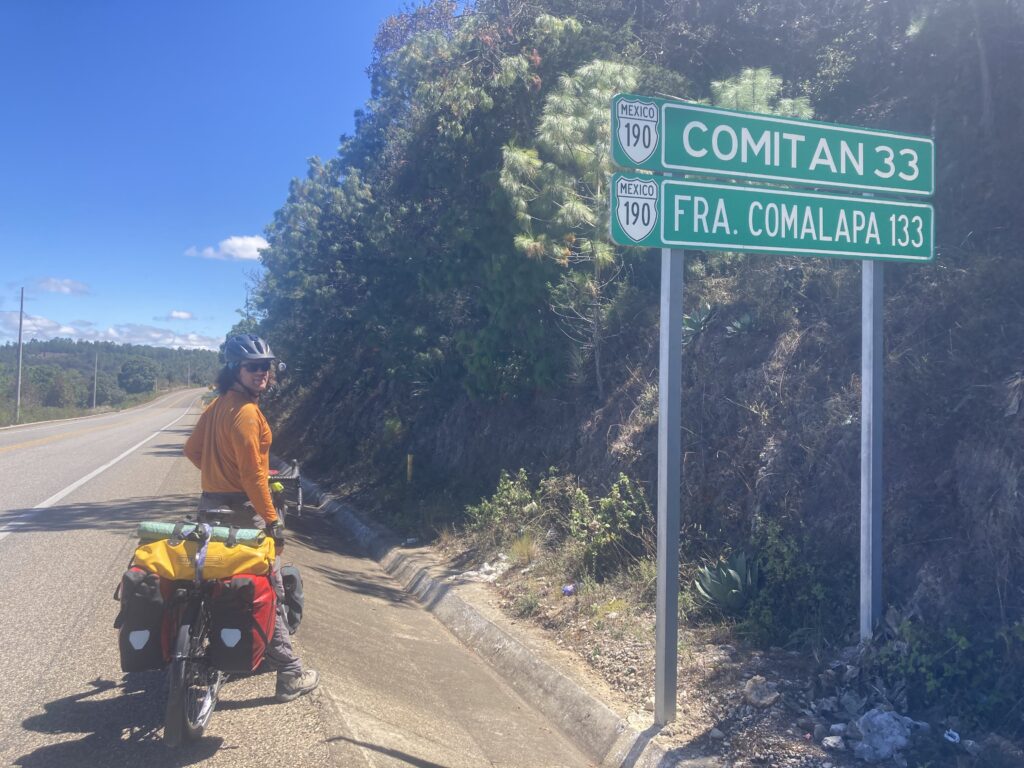
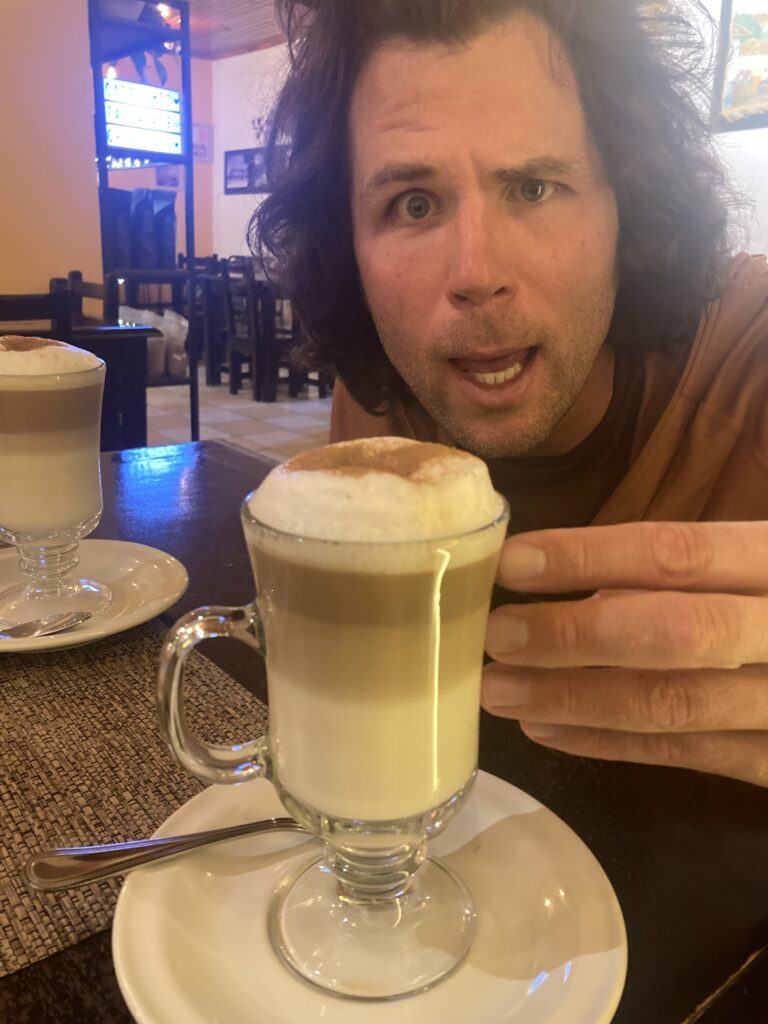
Border crossing: Mexico to Guatemala
We got to the border station in Mexico and saw a few vans full of “gringos” with agents guiding them through the process – seeds of doubt began to creep in, can we do this on our own? We did the entire entry process on our own, but hopefully we did it correctly! Now for exiting we’d done our internet research, we knew we needed to have our “FMM” (6 month tourist permit for Mexico) and we needed to get an exit stamp before proceeding to Guatemala. We were nervous because we’d both flown in and out of Mexico and we’d read online that the “FMM” was only for single land crossings. Worst case we’d have to pay a fine of $500MX each. Patricia went into the Immigration office first, waited less than 2 minutes, gave the agent her “FMM” card and her passport, just a few friendly questions, got her exit stamp, and was on her way! Easy peasy 🙂 All that stress for nothing!
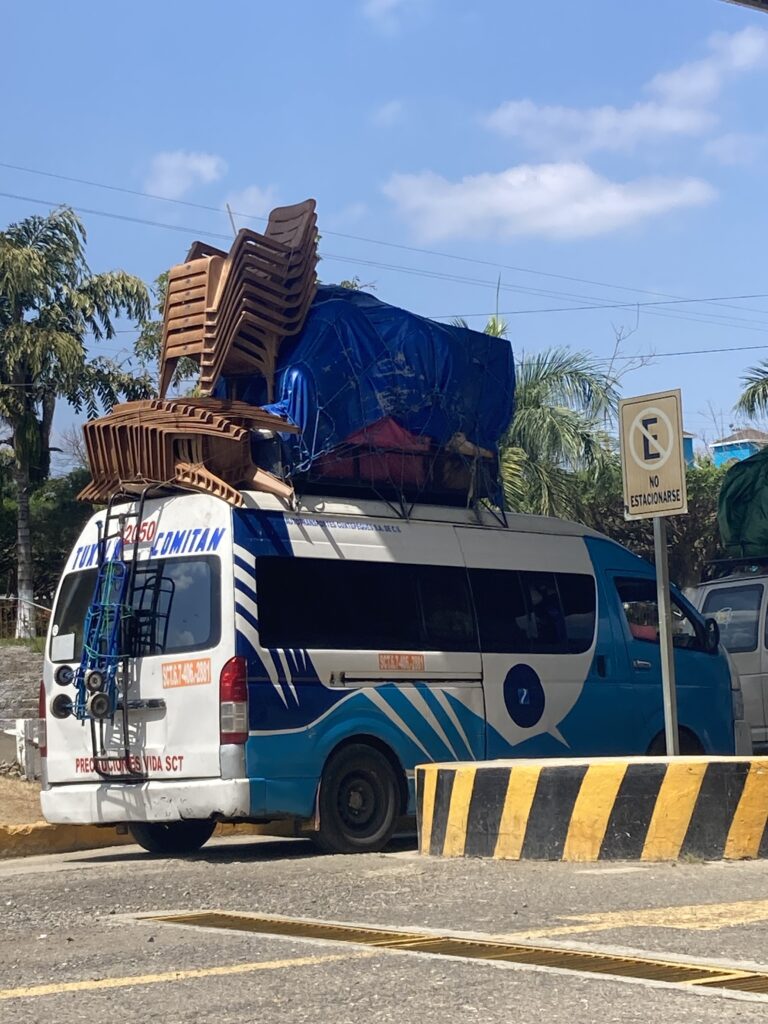
Next, we switched places and Patricia watched the bicycles while Dustin went into the office to get his exit stamp. Less than 5 minutes later we were set to head to Guatemala. It was an arduous sweat filled 7km uphill climb to Guatemala. On the way we stopped for a much needed break and rehydration – this was also a great way to use up our remaining small pesos.
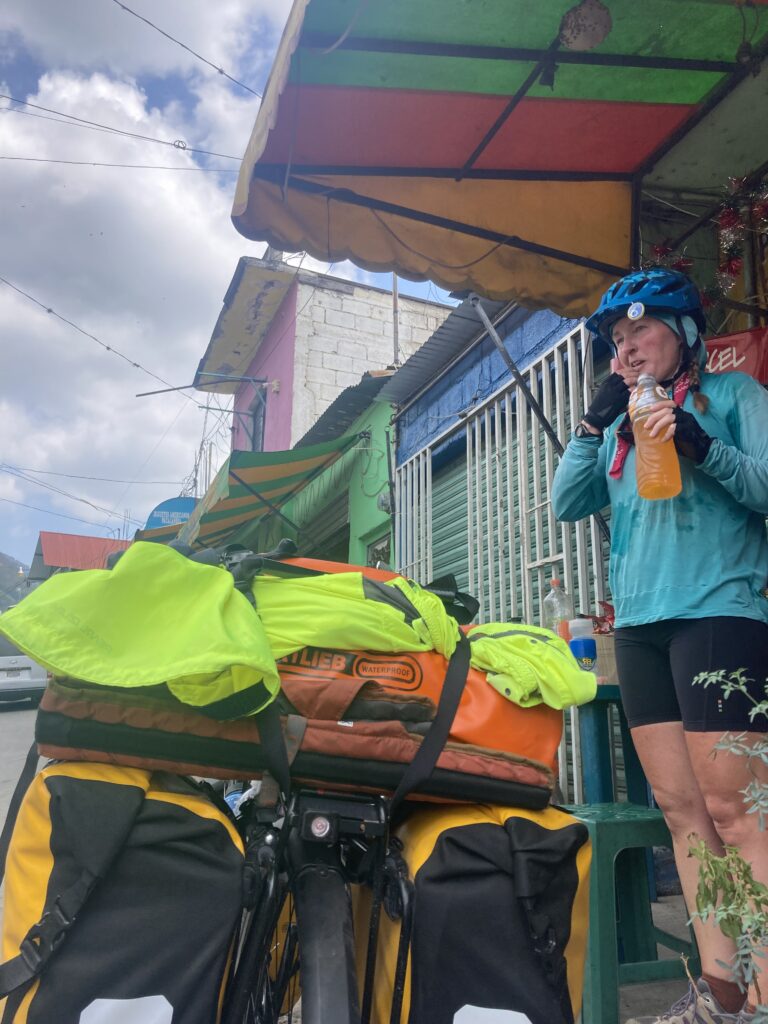
The actual border between Mexico and Guatemala was quite fluid – there was no guard shack stopping people and asking for passports, it just seemed like one continuous town. We knew once we crossed we had to stop at the Guatemalan immigration office to get our entry stamp. We asked a local man where the immigration office was and he said (in Spanish) just ahead on the right. We cycled a bit further and were guided right into the office by one of the money changers – they help you out so that you’ll change money with them at poor exchange rates. He even offered to watch our bicycles.
Guatemala
Patricia went into the Guatemalan immigration office and there was no one at the counter. After waiting for a few minutes she walked back outside and gestured that no one was there. Our new amigo, the money changer, went into the office and whistled for the immigration officer – a minute later he appeared. Patricia gave him both passports, he found the Mexican exit stamp, and then stamped them both for entry into Guatemala with barely having a look at Dustin. Done – we were now officially in Guatemala! We changed our remaining pesos with the helpful money changer, at an OK rate for border town money changers.
We rode on up the hill in the border town, it was so busy with shops, people, motos, tuk-tuks, dogs, etc. we wanted to get out as quickly as possible. On the way out Patricia had her first collision with a human – a delivery boy ran into her and her bicycle. No damage done, everyone went their separate ways.
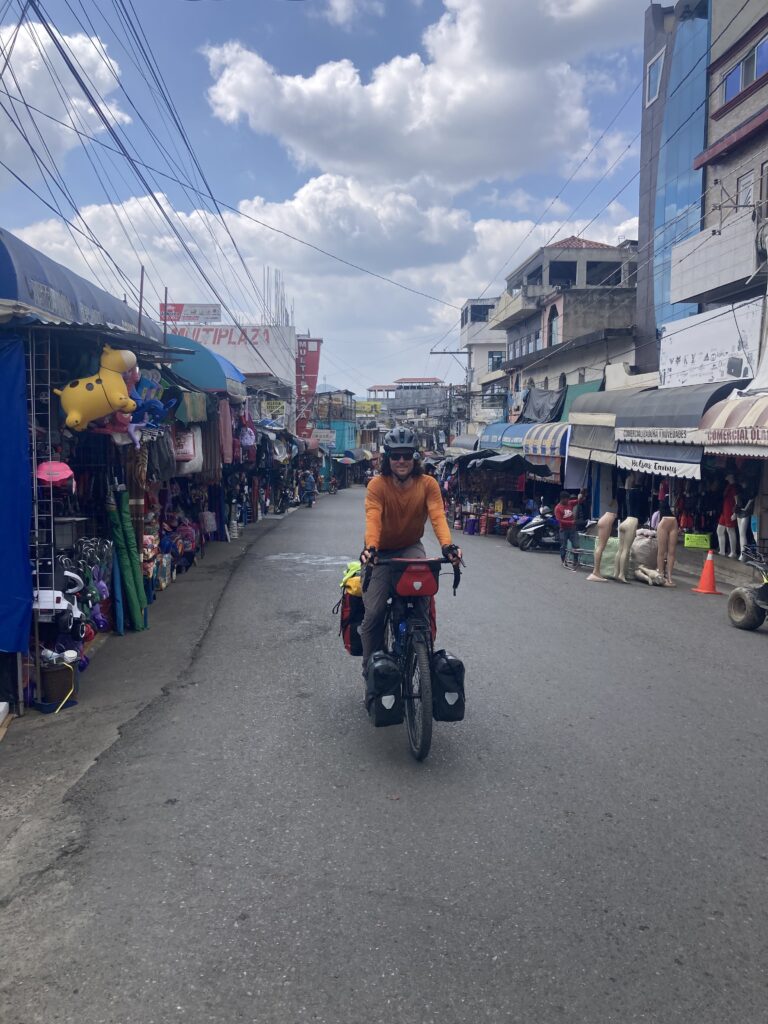
Very quickly we noticed more hectic traffic including the famous aggressive and fast “chicken busses” (more on these later). We had to be on our toes with little to no shoulder, poor road conditions, and aggressive drivers. We rode about 10k to Camoja where stayed our first night in Guatemala – too tired to look for a more modestly priced hotel we stayed in a posh little accommodation with air-conditioning and a swimming pool on the roof!
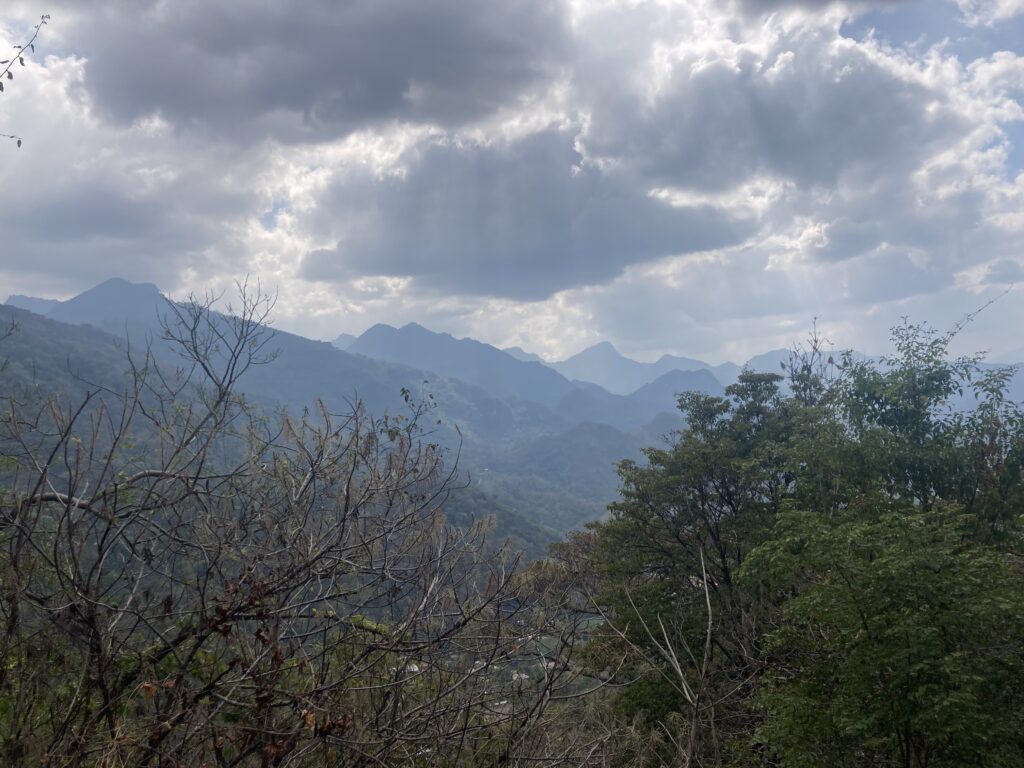

Exhausted, but knowing we needed to get supplies and money, we went out into town looking for bread, fruit, and an ATM. Success on all accounts, we went back to the hotel, showered, and were asleep by 8:30pm.
Climbing the Sierra Madres to Lake Atitlan
For the next three days we did our toughest cycling segment to date climbing a total of over 13,500 feet! The scenery was spectacular but was physically brutal yet we were blown away by the generosity of the local Guatemalans. We thought the people of Mexico were very friendly but Guatemala might have them beat!
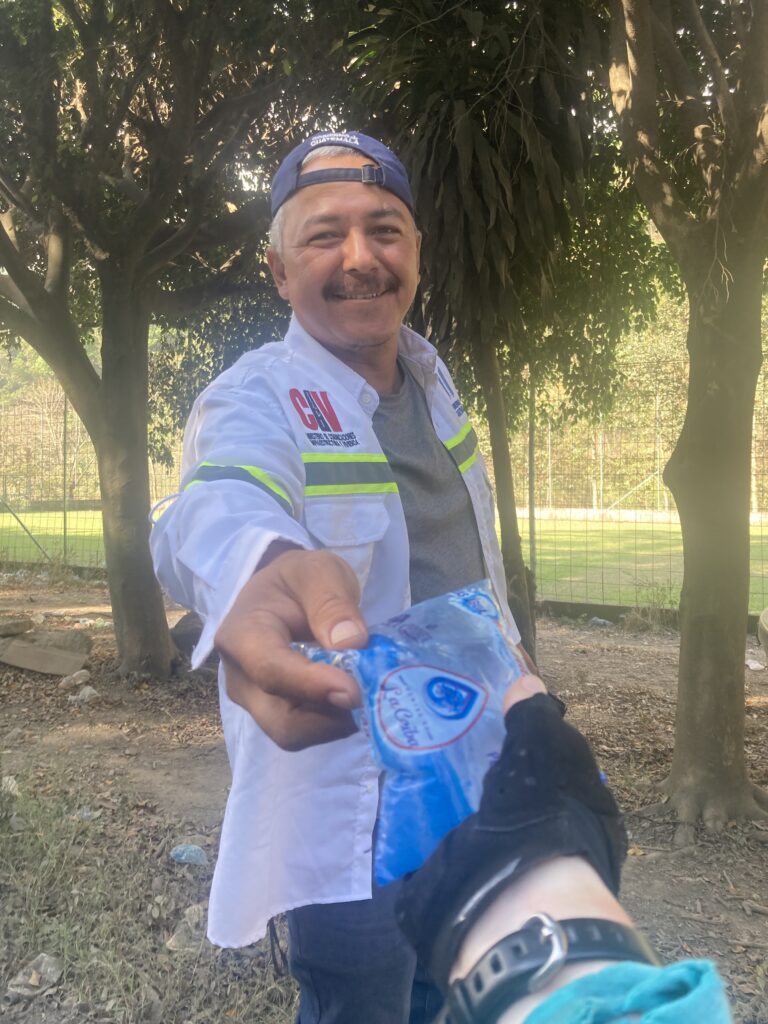
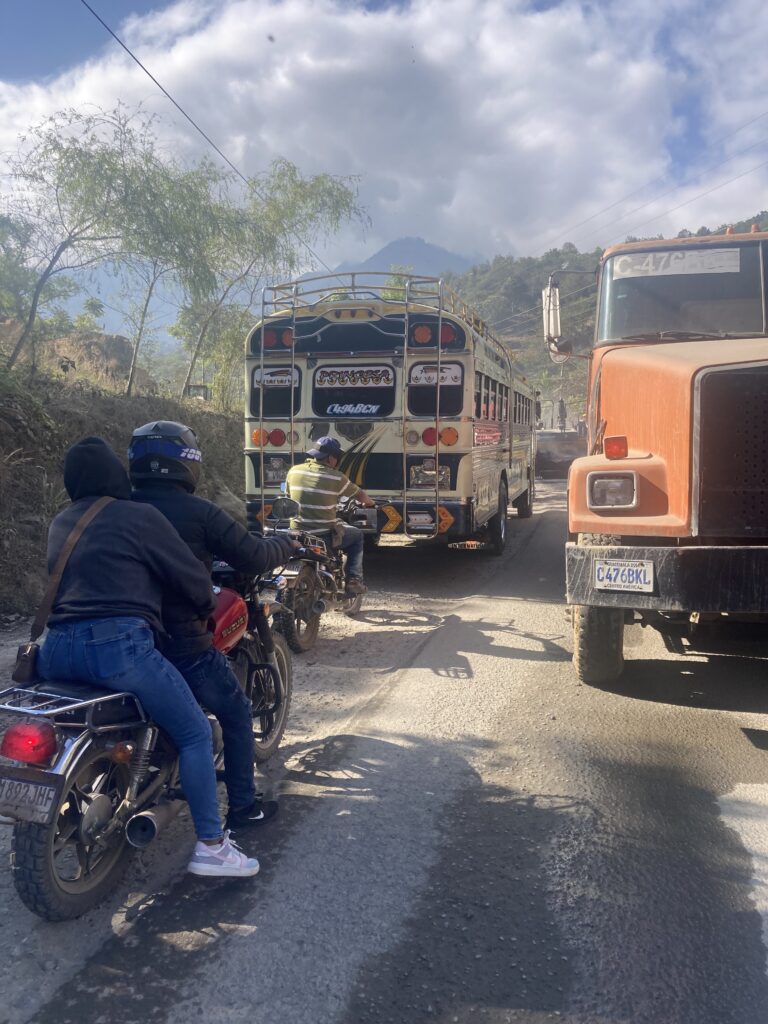
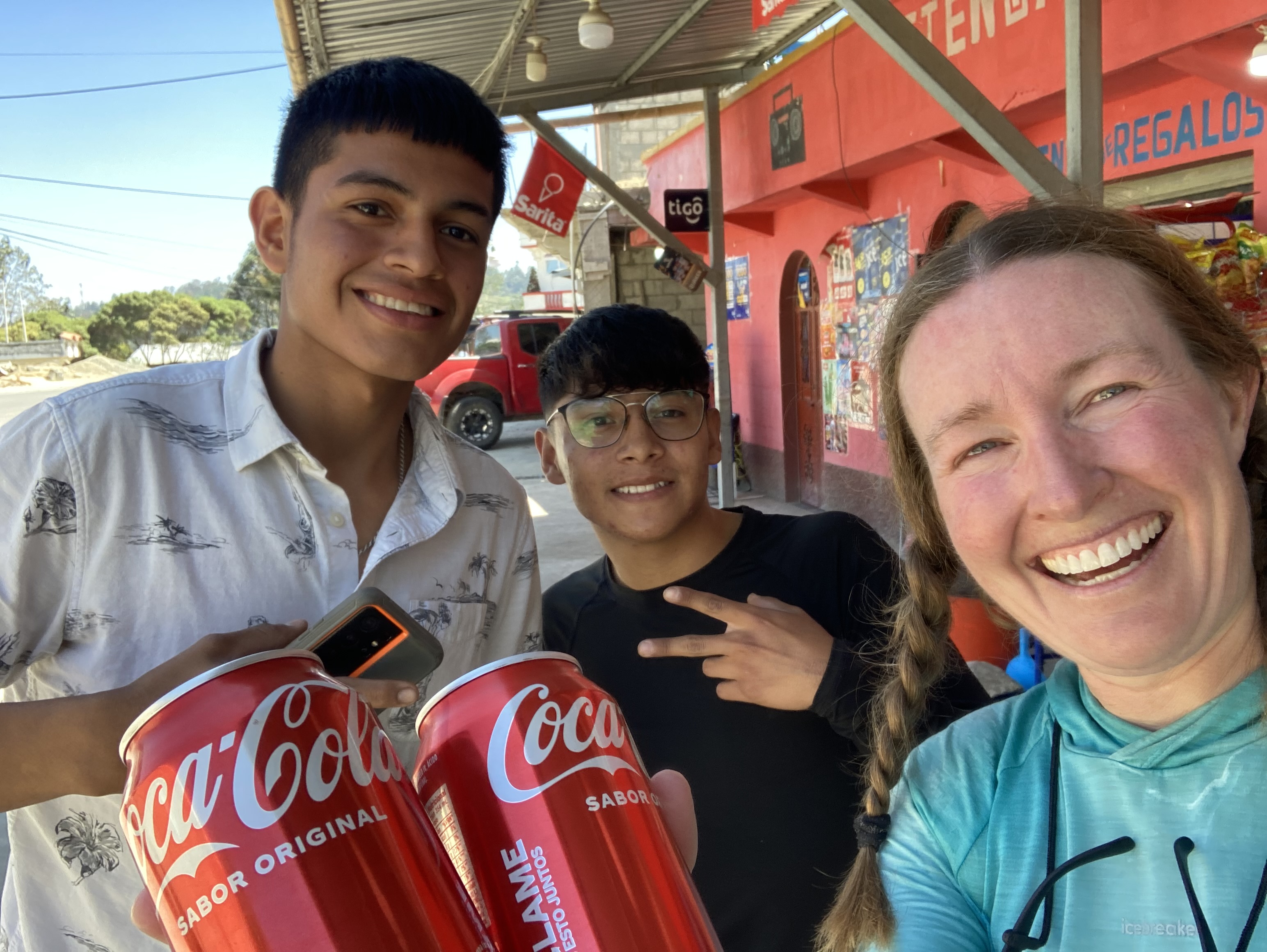
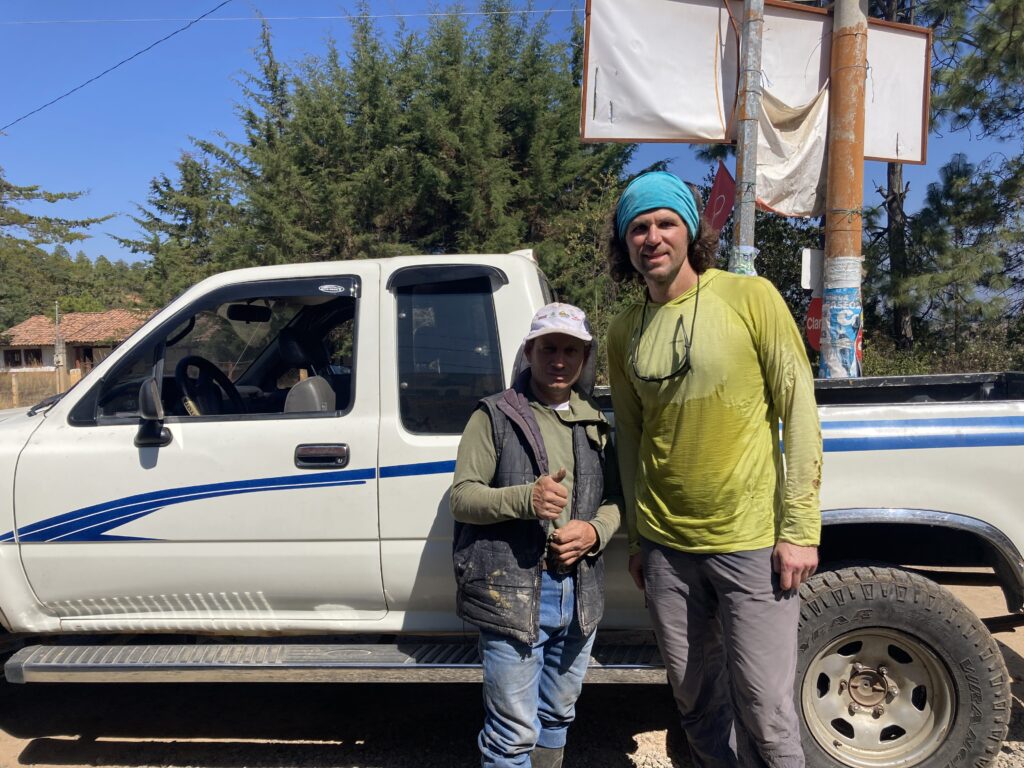
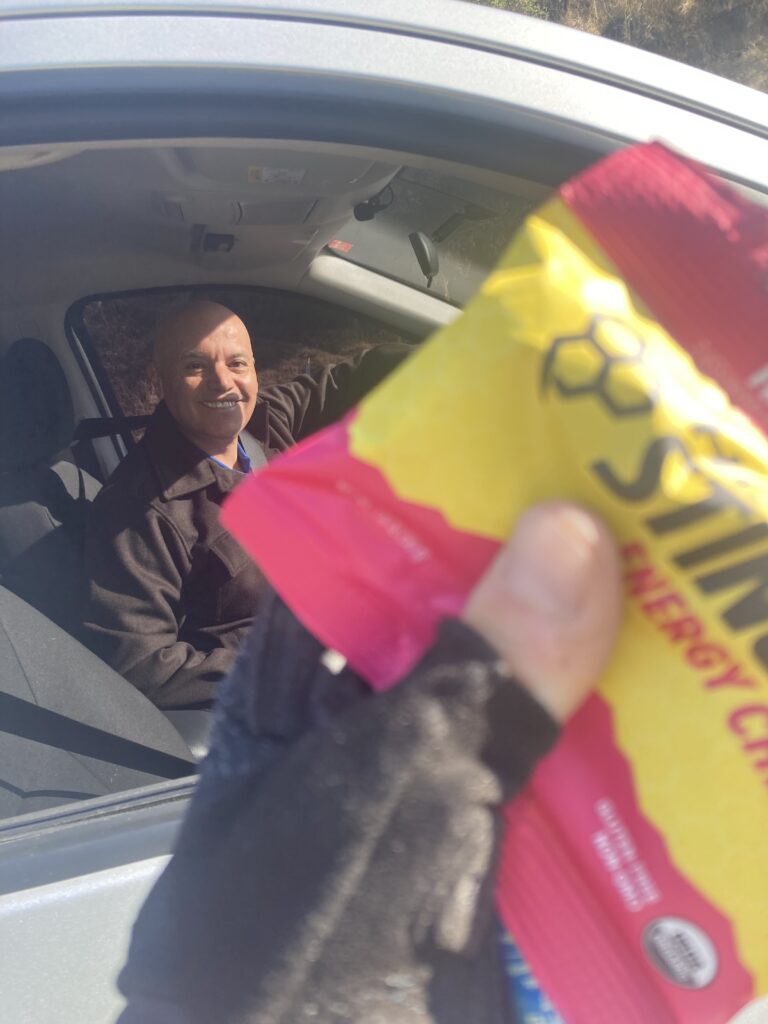
Lake Atitlan
At the end of our three days of strenuous climbing and an epically steep downhill into Panajachel, Guatemala, we arrived at the famous Lake Atitlan. The lake was surrounded by pointy volcanic peeks and was formed by a caldera when a previous magma filled chamber collapsed.
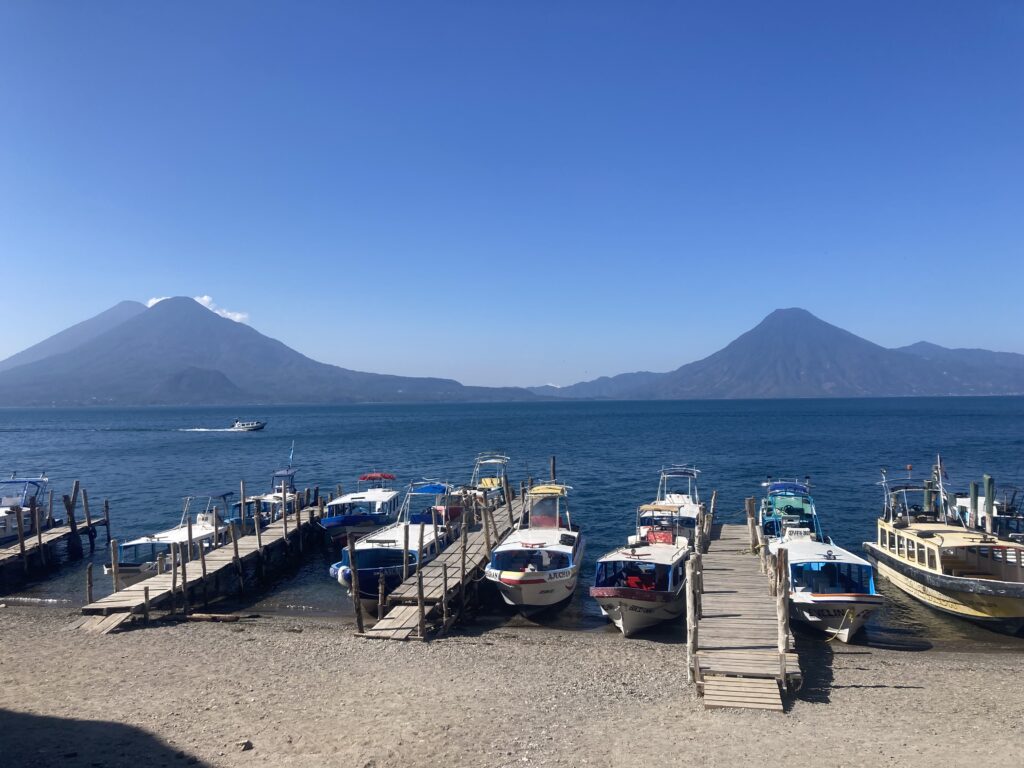
A rest day in Panajachel allowed us time to explore the town and, more importantly, to do our laundry! Our clothes get so dirty very quickly with sweat, salt, and road grime. Do-it-yourself laundymats are not as common here so we’ve taken to handwashing most of our clothes. “Lavandarias” (laundry washing services) are everywhere but most of our clothing is wool and we just don’t want to risk a misunderstanding between languages and shrink all our clothes!
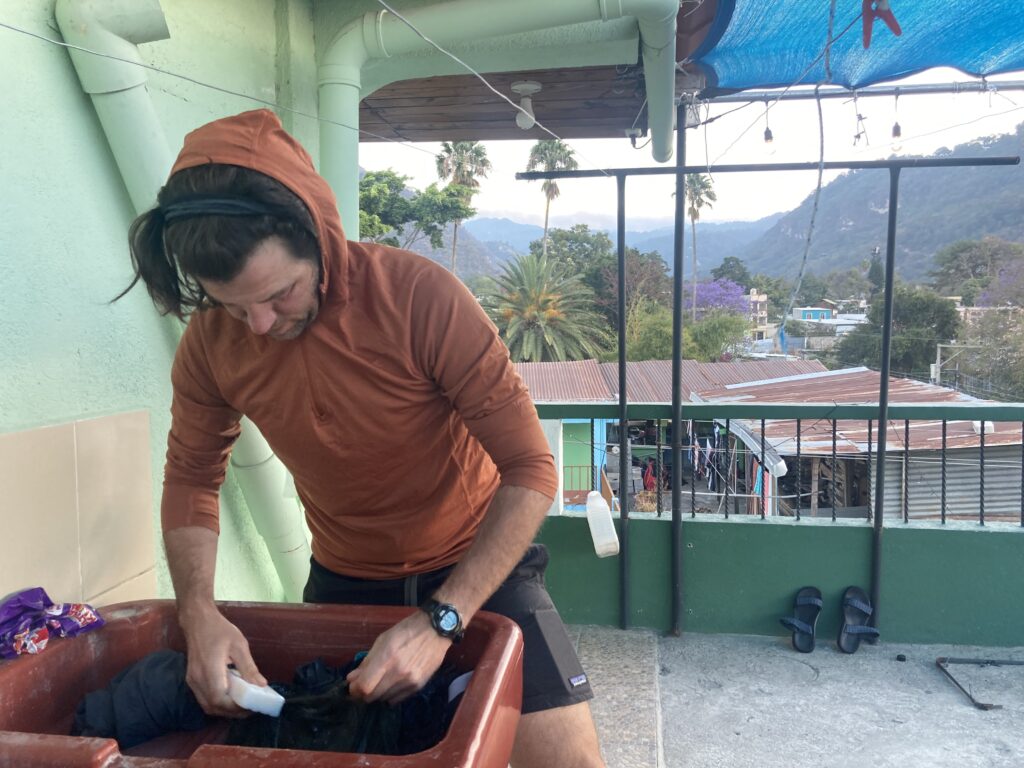
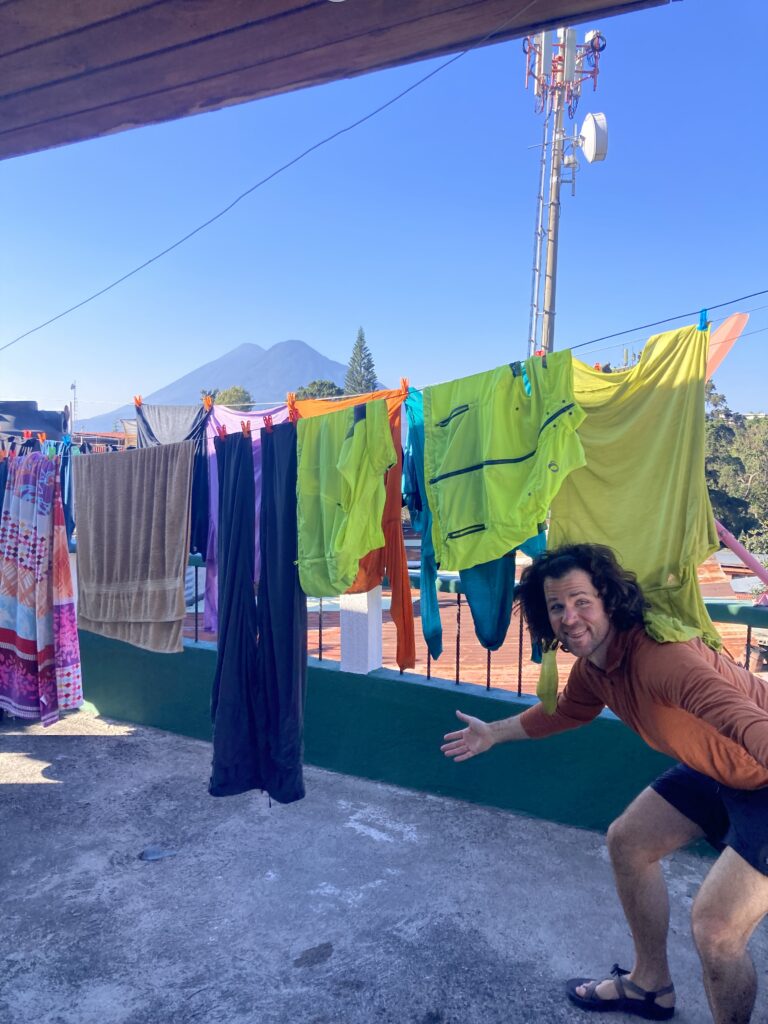
After a rest day we took a lancha across the lake to San Lucas Toliman, a town Dustin had visited 20 years ago. To stroll even further down memory lane we stayed at the same accommodation he had stayed at way-back-when. We walked around town and he shared memories he had from his previous trip. San Lucas Toliman is a working class town and not a tourist town as many of the other Lake Atitlan settlements were. The town had progressed since Dustin’s first trip – paved roads, new buildings, taller buildings, etc.
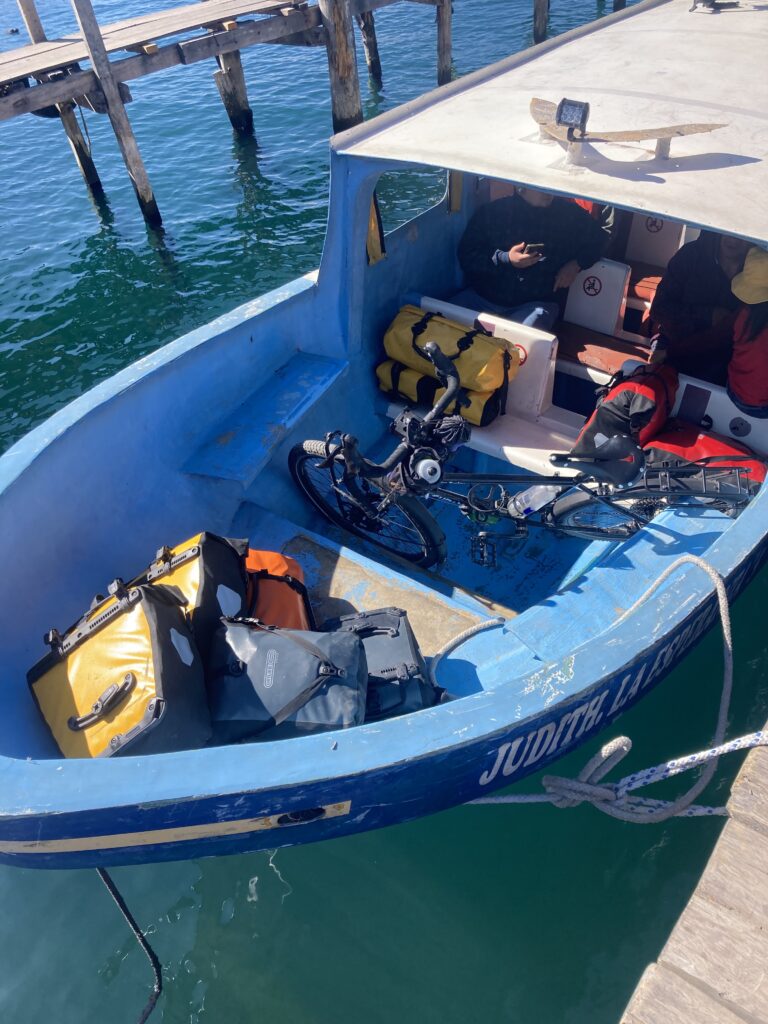

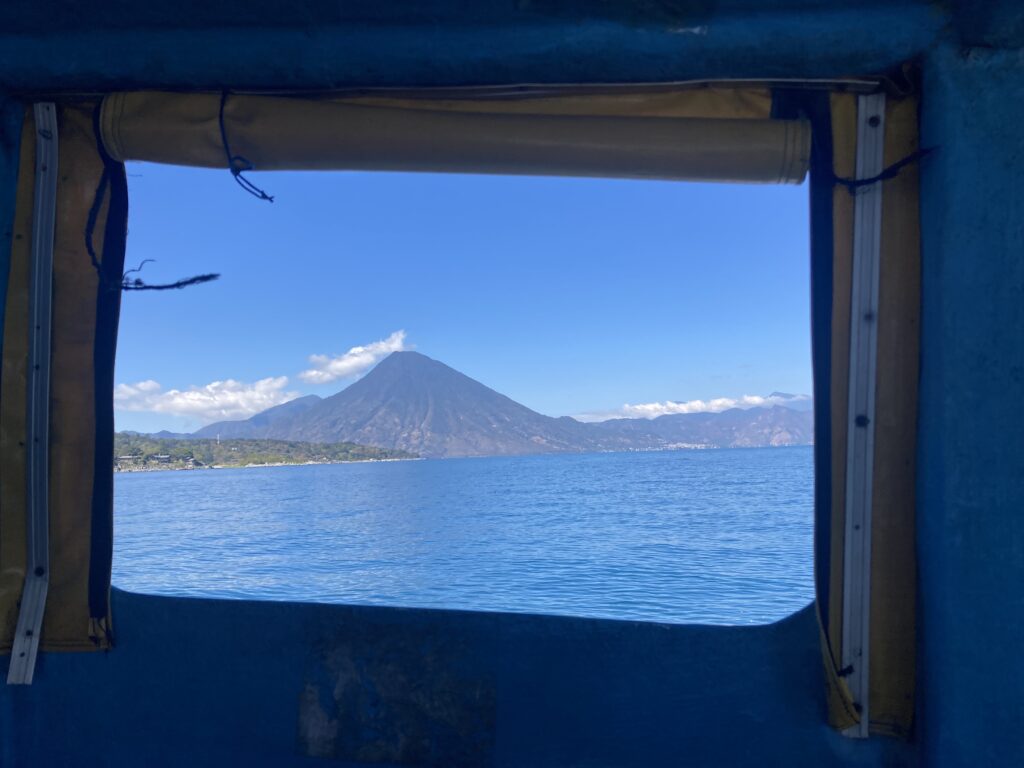
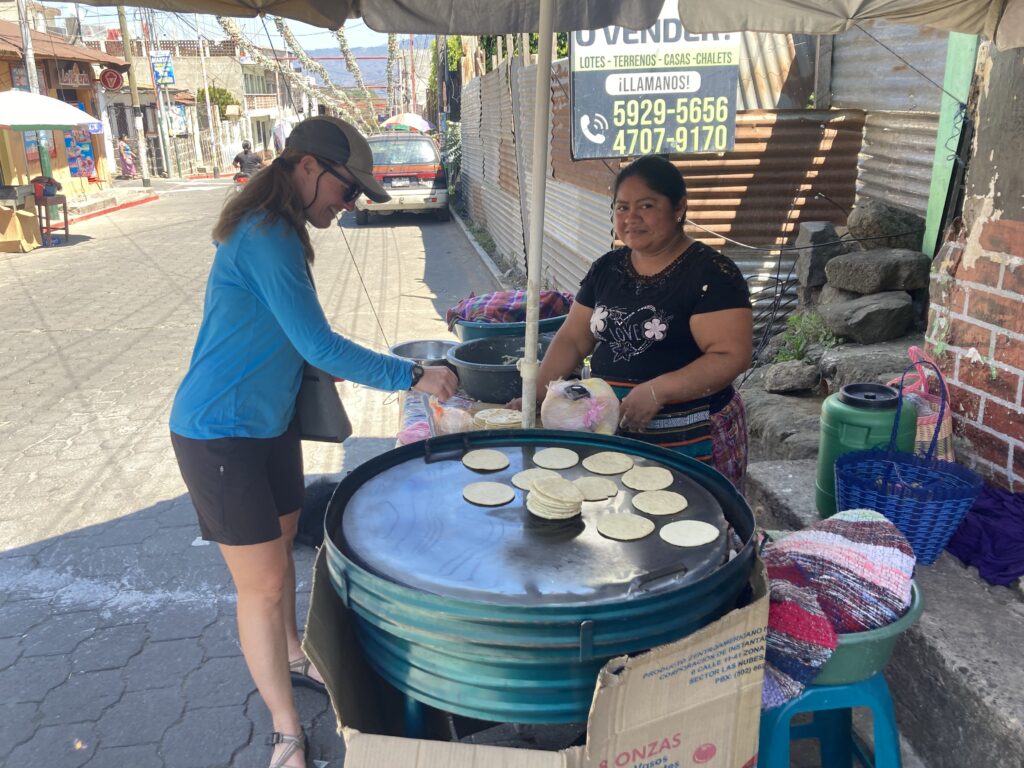
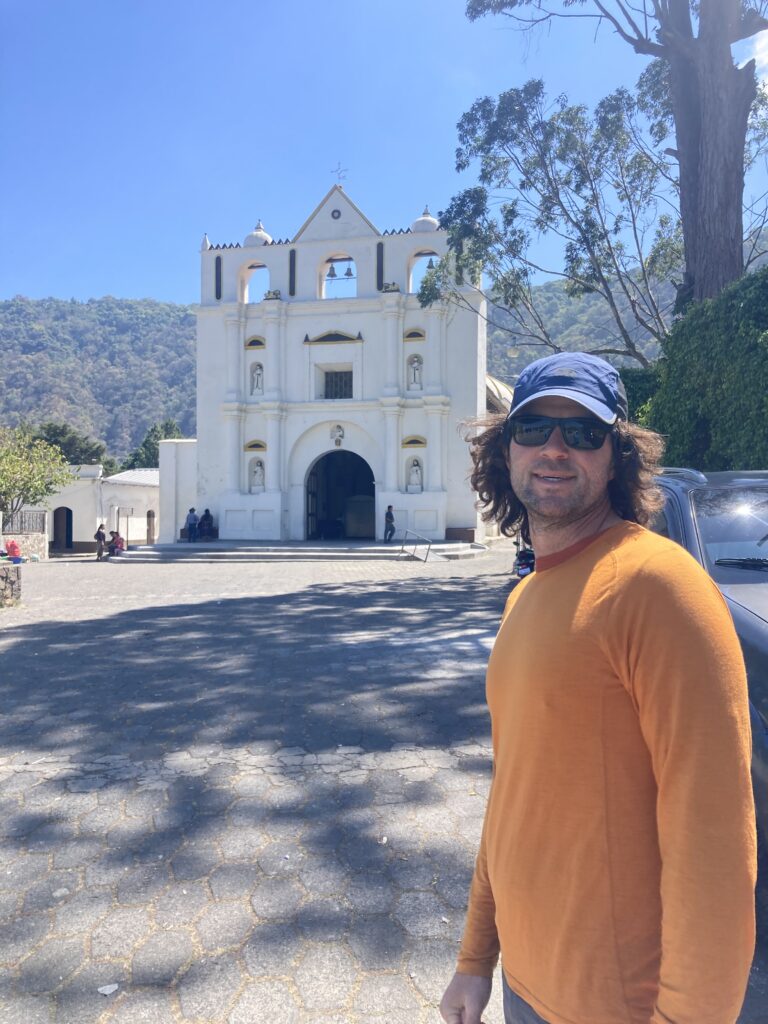


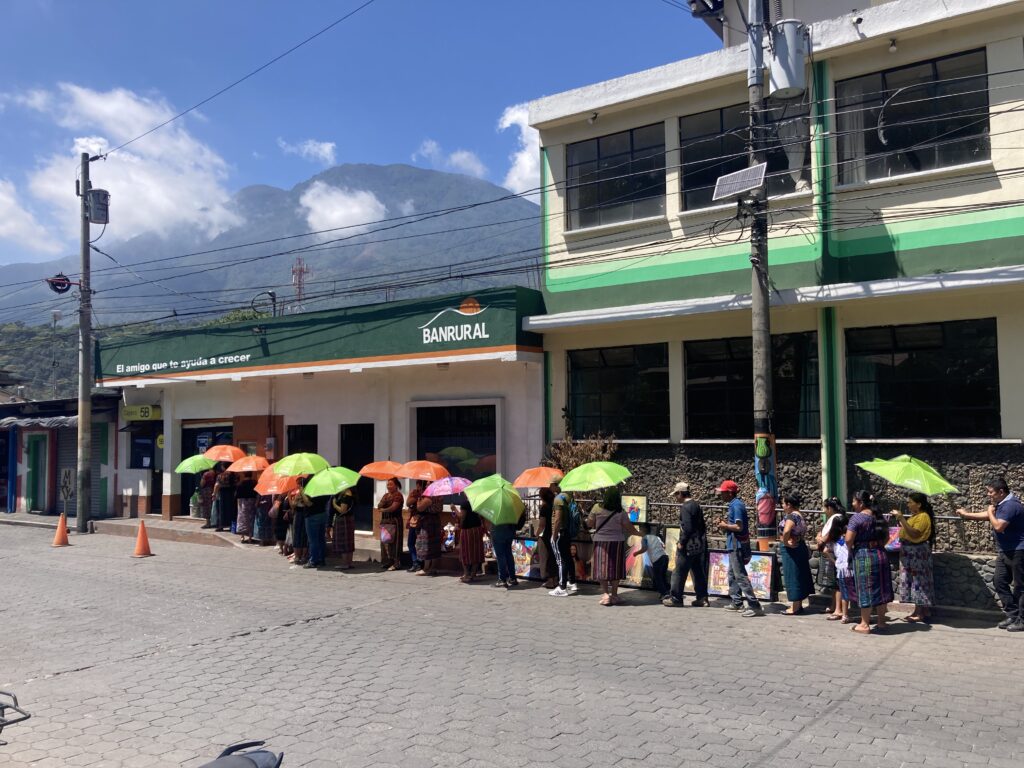
Getting parasites
Way back in Mexico, specifically San Cristobal, we’d heard of several bicycle tourists who became sick with intestinal parasites – “everyone gets sick in San Cristobal” was what we’d read. We’re *super* careful: bottled water for tooth brushing, cooking only in purified water, wash hands constantly, spit out any water from the shower, etc. so we didn’t think we’d become a victim of protozoa…and yet we acquired these unwanted gastrointestinal hitchhikers, most likely in San Cristobal, Mexico.
Sparing most of the details, yet providing enough information – we didn’t feel nauseous or ill but we had liquid coming out of the incorrect orifice for too many days. At first we thought “this will just go away” – well it didn’t. So off to the famacia we went.
With the help of google translate we described our symptoms to the pharmacist and within 10 minutes we were on our way with an anti-protozoan and a probiotic to rebuilt our gastrointestinal health. One nice thing here is that you don’t have to go to a doctor and then to a pharmacy – it’s one stop shopping at the famacia!
We followed the instructions given by the pharmacists, translated by google, and then double checked with “Dr. Google” and within a few days we were back to normal 🙂

Hot & Humid Lowlands
Lake Atitlan is a tourist destination for good reason – the weather is very comfortable. While we were there the night time temperature was in the 50s Fahrenheit each night making sleeping very comfortable without air conditioning. We’d been cycling in the “highlands” since long before Mexico City and the cooler temperatures were our lovely trade-off for serious mountain climbing.
Now we were headed to lower elevations and toward the hot & humid coast. We made one more stop-over, at Esquintla, before making our way to the El Salvador border. Riding in the heat (mid-90s F) and high humidity is challenging. We try to leave early (like 6:30am) and make frequent cold drink stops at gas stations or tiendas to get COLD (hopefully) sports rehydration drinks and water. Honestly not much helps – its HOT & HUMID! Our entire bodies are covered in salt & sweat – at the end of the day we just want to be in an air-conditioned hotel room with a shower.

After one rehydration stop we were 25km from the El Salvador border, our target destination for the day, and when we began riding again we quickly saw semi-trucks stopped ahead. Hmmmm….wonder what’s going on? We’d heard that the trucks would be backed up at the border for about 4km but we were 23km from the border. Maybe there’s an accident? We biked around the trucks and the line continued as far as we could see and all the way to the border. The right lane was a 23km (14 mile) long line of trucks waiting to get to the border! It was a very long ride on a hot day so being encouraged, entertained, and shaded by the truckers & trucks made this last segment of riding quite interesting.

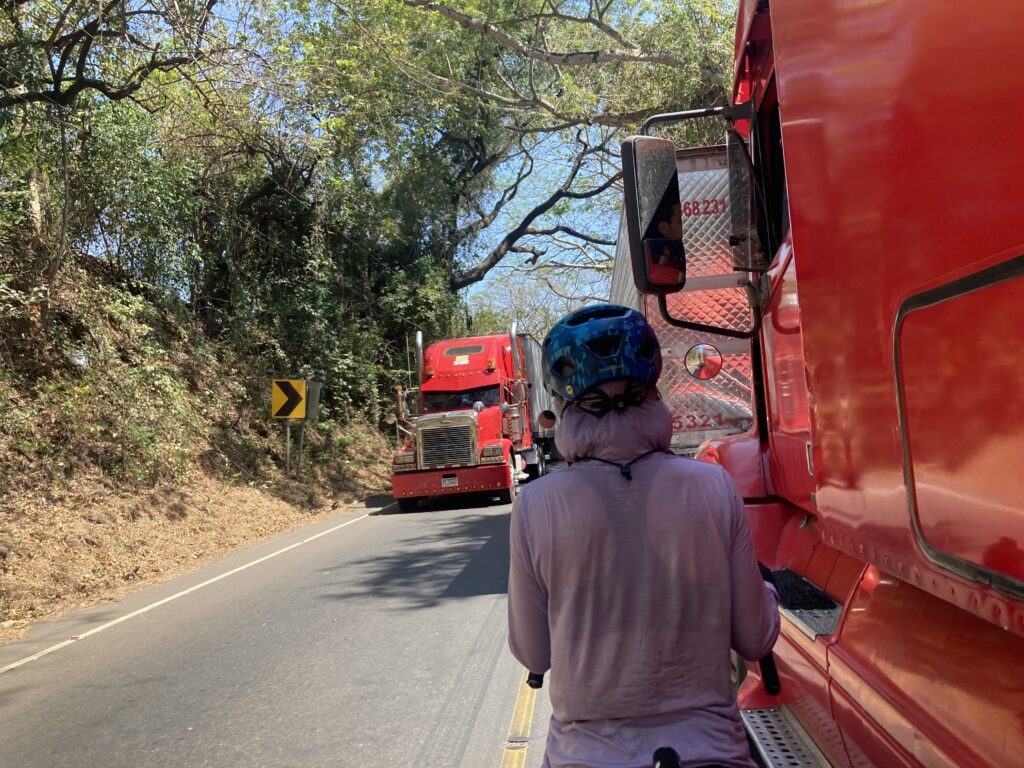

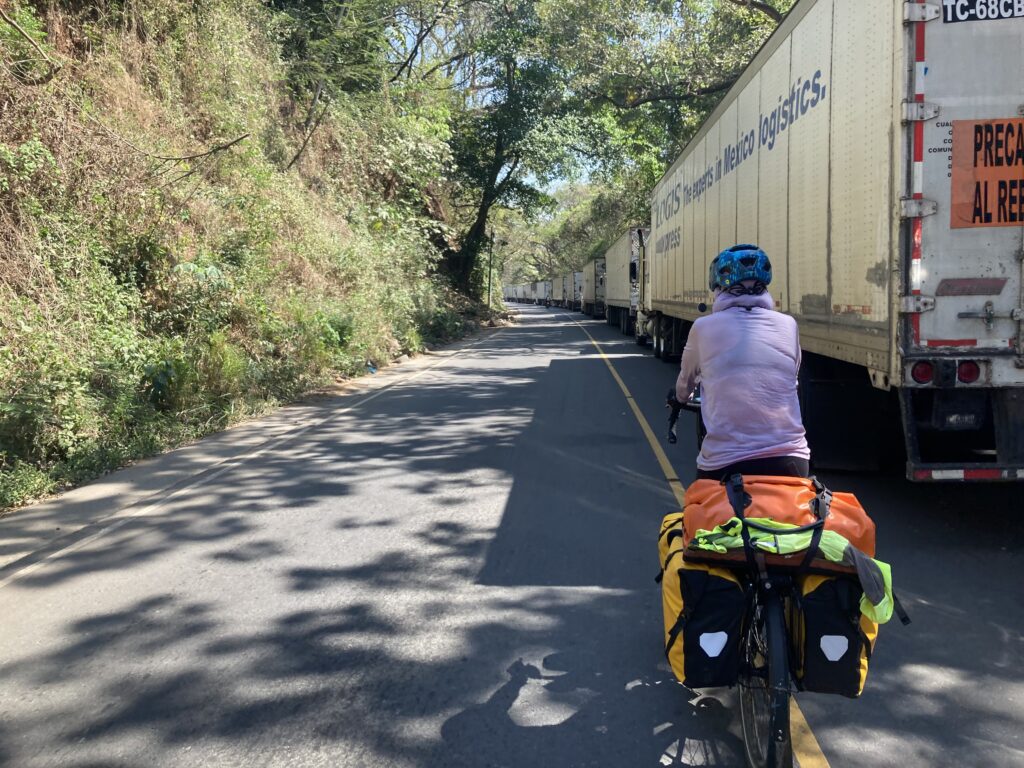
Since these men, we didn’t see any women drivers, were living on the side of the road for days there were also vendors coming along with water, food, cleaning supplies, diesel, etc – anything they might need. It was unbelievable but the truckers seemed undeterred, it was simply how they lived.
We simply cycled past this huge line of trucks up to the front of the queue and went to Guatemalan Immigration to get our exit stamps – easy peasy, only took about 5 minutes. Then we cycled, with the trucks, over to the El Salvador side and went to immigration. We were surprised to learn we had to pay $12 each for our tourist card in El Salvador – everything we’d heard from other cyclists was that El Salvador visa was “free”. Well, there are a handful of countries that have to pay – we asked the kind immigration officials if we could snap a picture of the sign of who has to pay so we could share it with the bicycling community, “Sure, no problem”.
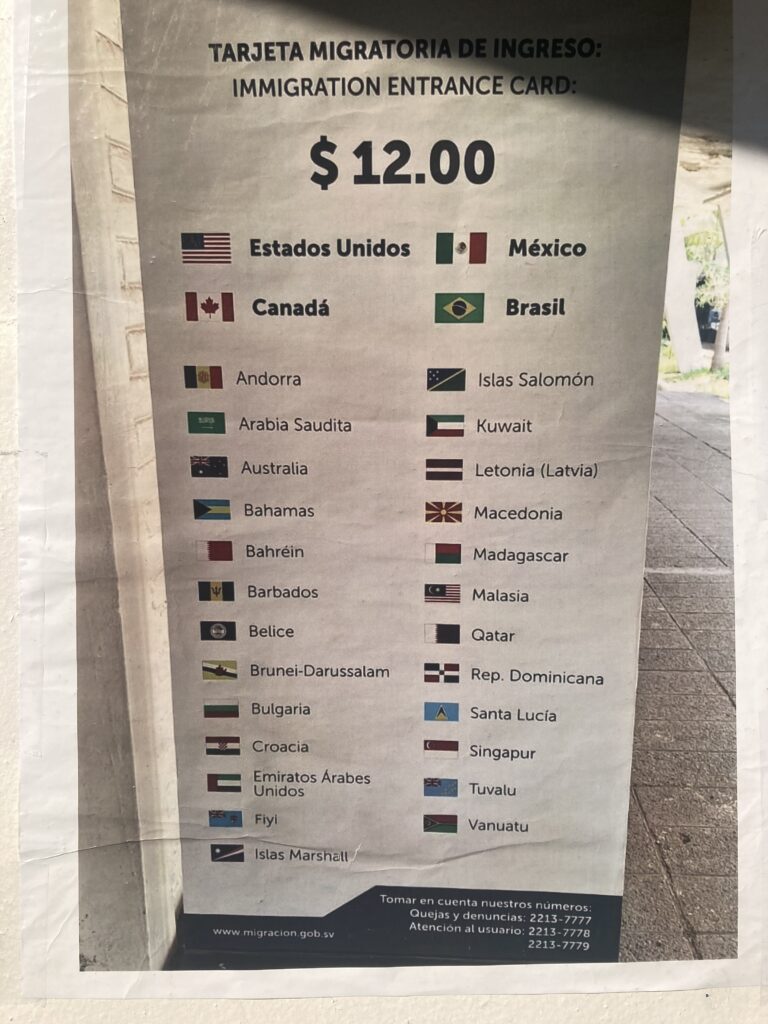
El Salvador
After 30 minutes of processing, mostly waiting for a van full of tourists who had paid an agent to assist them at the border, we were in El Salvador – country #5! It had been a Long. Hot. Day. so we decided to stay just across the border at La Hachadura, El Salvador. We found a nice little hotel, settled in, and then went back to the border area (literally 2 blocks away) to see about exchanging our Guatemalan money. Since 2001, El Salvador uses the US Dollar – we were shockingly pleased at the rate offered by the money changer, usually the border money changers offer quite poor rates for exchanges. It felt comfortable, yet weird, to use USD again! One significant difference was the prolific use of $1 coins – from our experience, these really haven’t taken off in the US, but so far everywhere we’ve been in El Salvador we have received $1 coins instead of bills as change.
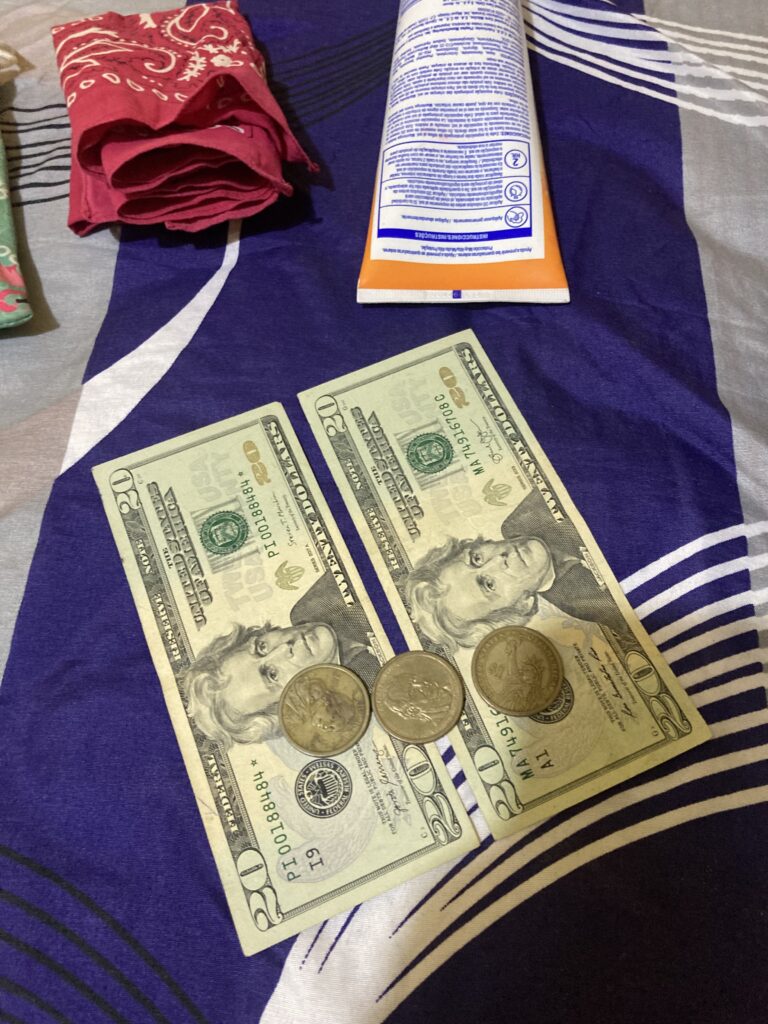
For the next two days we cycled along the El Salvadoran coast yet stayed in two drastically different towns. Our first town was Acajutla, El Salvador’s largest port as well as a beach town that was past it’s hay-day. We attempted 4 different accommodations that were “closed”, “didn’t have water”, “wouldn’t be ready until 5pm”, before securing a room at a Restaurant/Hotel. We ended up with a nice oceanview room that easily accommodated the bicycles but required us to carry all our gear up two flights of stairs. The nerds in us enjoyed counting the commercial shipping vessels off the coast waiting to enter the port – just from our room we could see 14!

Acajutla was a busy commercial port and not touristy at all. We appeared to be the only gringos in town enjoying watching the sunset over the Pacific.
The next day we rolled out of town early, we were pedaling by 6:40am, and headed to another beach town, El Zonte. The route climbed and descended along the coast for spectacular views. The high temperatures, low 90s F, and high humidity made for a very sweaty ride. After we’d been at it for almost 3 hours we stopped at a thatched roofed, cliffside restaurant for a break where we observed migrating whales off the coast.
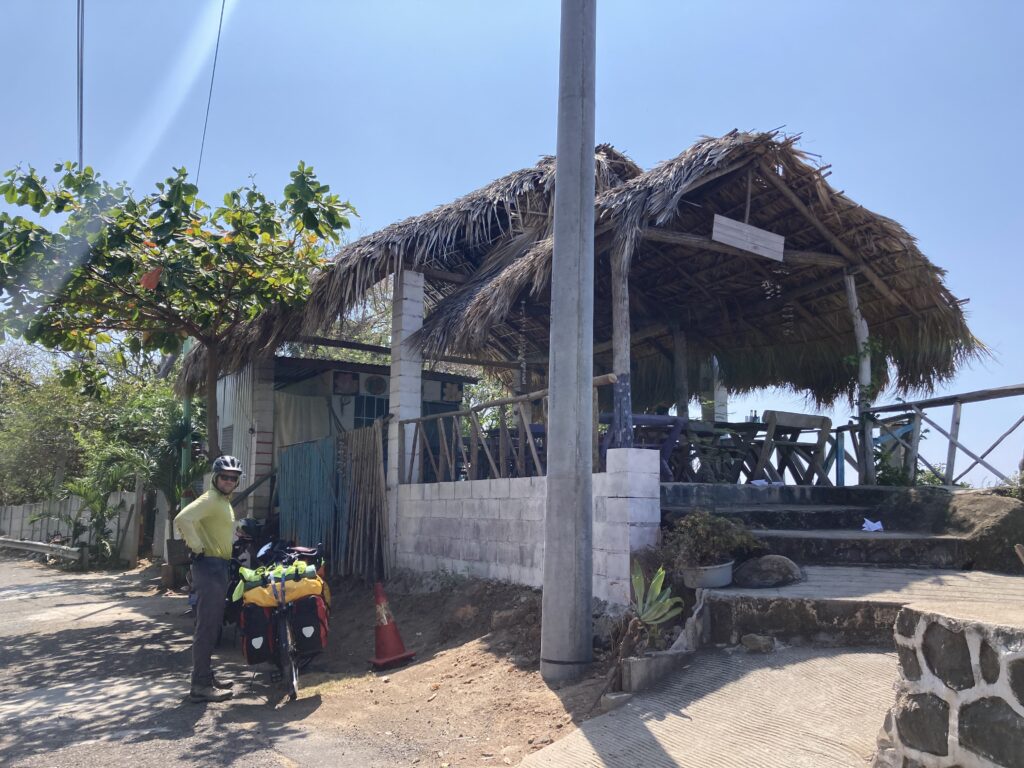
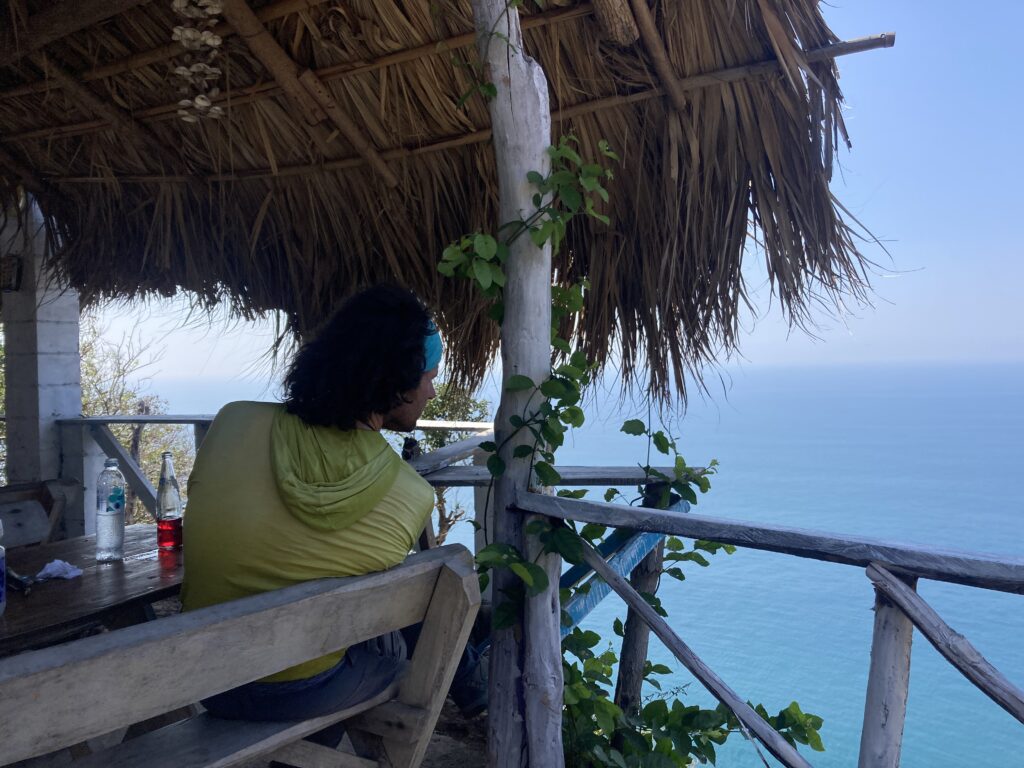
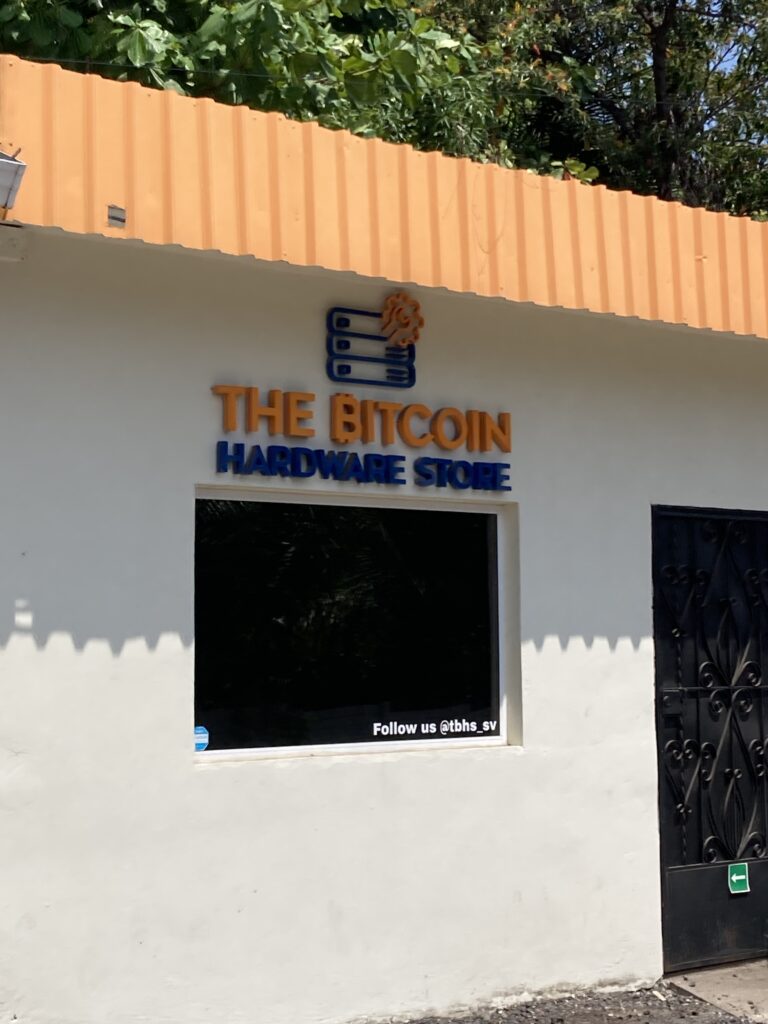
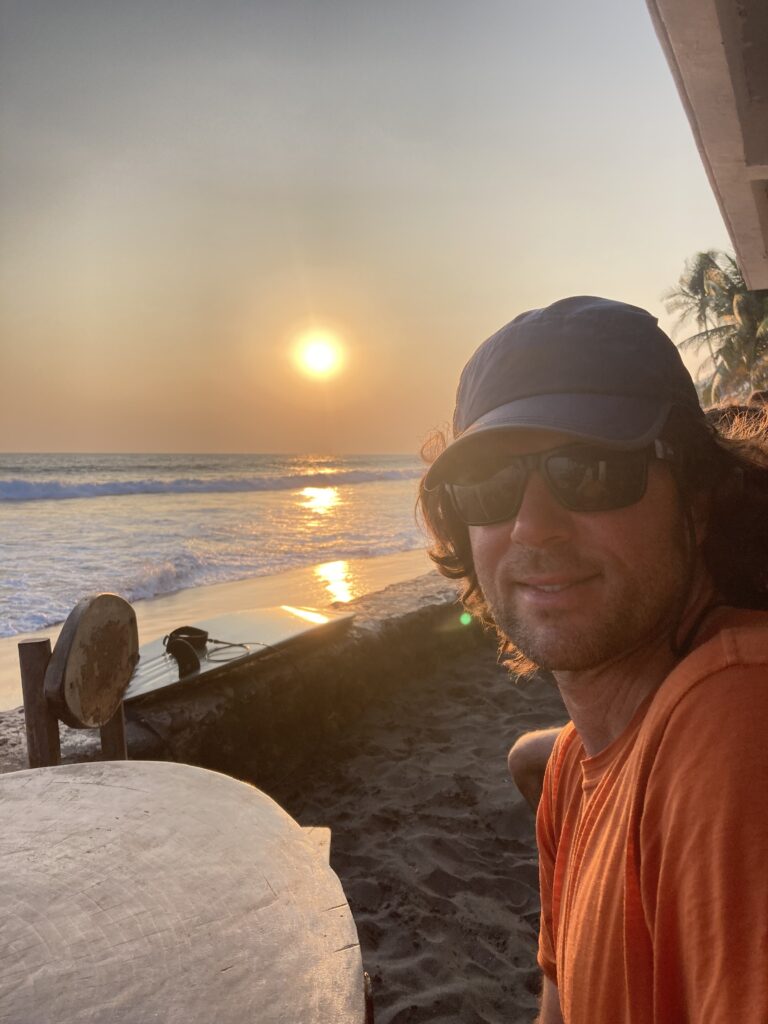
For the next three days we rode toward the border with Honduras stopping along the way in working class towns of Zacatecoluca, San Miguel, and Santa Rosa (de Lima). It was HOT & HUMID. We started very early most mornings just after 6am and stopped frequently to cool down in air conditioned gas/convenience stores, if we could find them. We sweat so much and tried to keep up our liquid intake to replace what we’d lost but it often was a losing game. Patricia got so hot/sweat so much that she developed heat/sweat rash all over her legs – living the dream



Honduras
We only spent two days in Honduras as a result of the small area it occupies on the Pacific Lowlands area; Honduras has a much larger coastline on the Atlantic side. We have been starting to bicycle right at sunrise, about 6am, because it is so HOT & HUMID (have we mentioned it’s hot & humid lately???!!!). We stayed about 15km (9 miles) from the border so we arrived at the border just past 7am – luckily, at this time of day, there were no lines to check out of El Salvador or to get our visitor permit for Honduras – we only spent about 30 minutes total with immigration tasks.
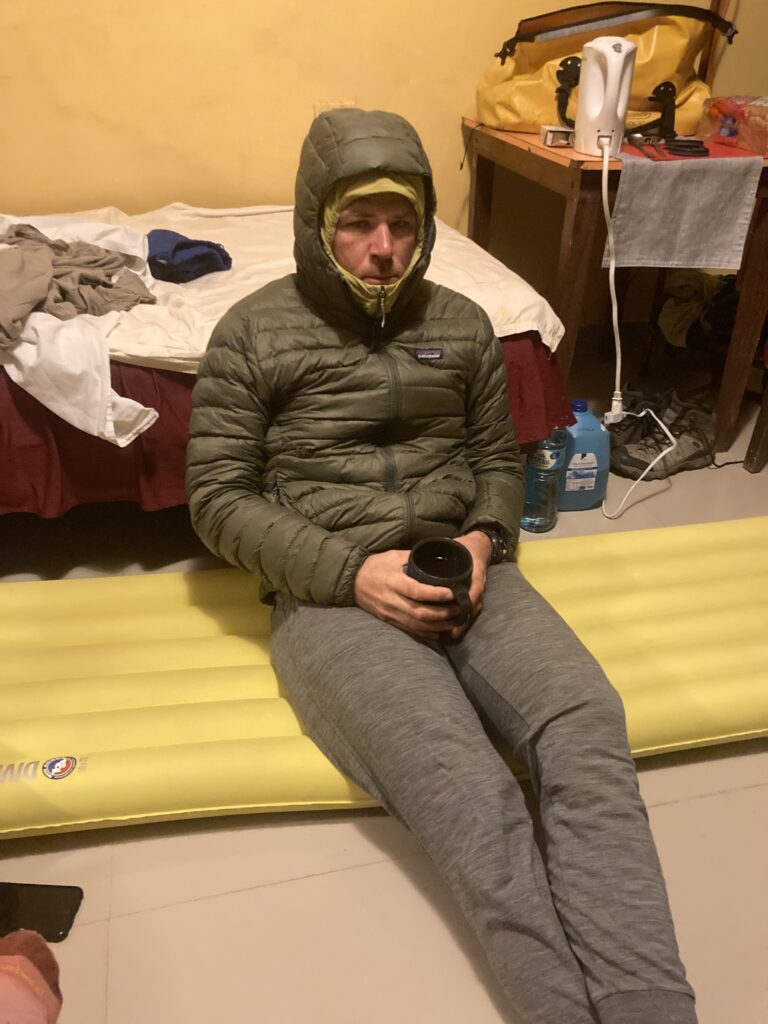
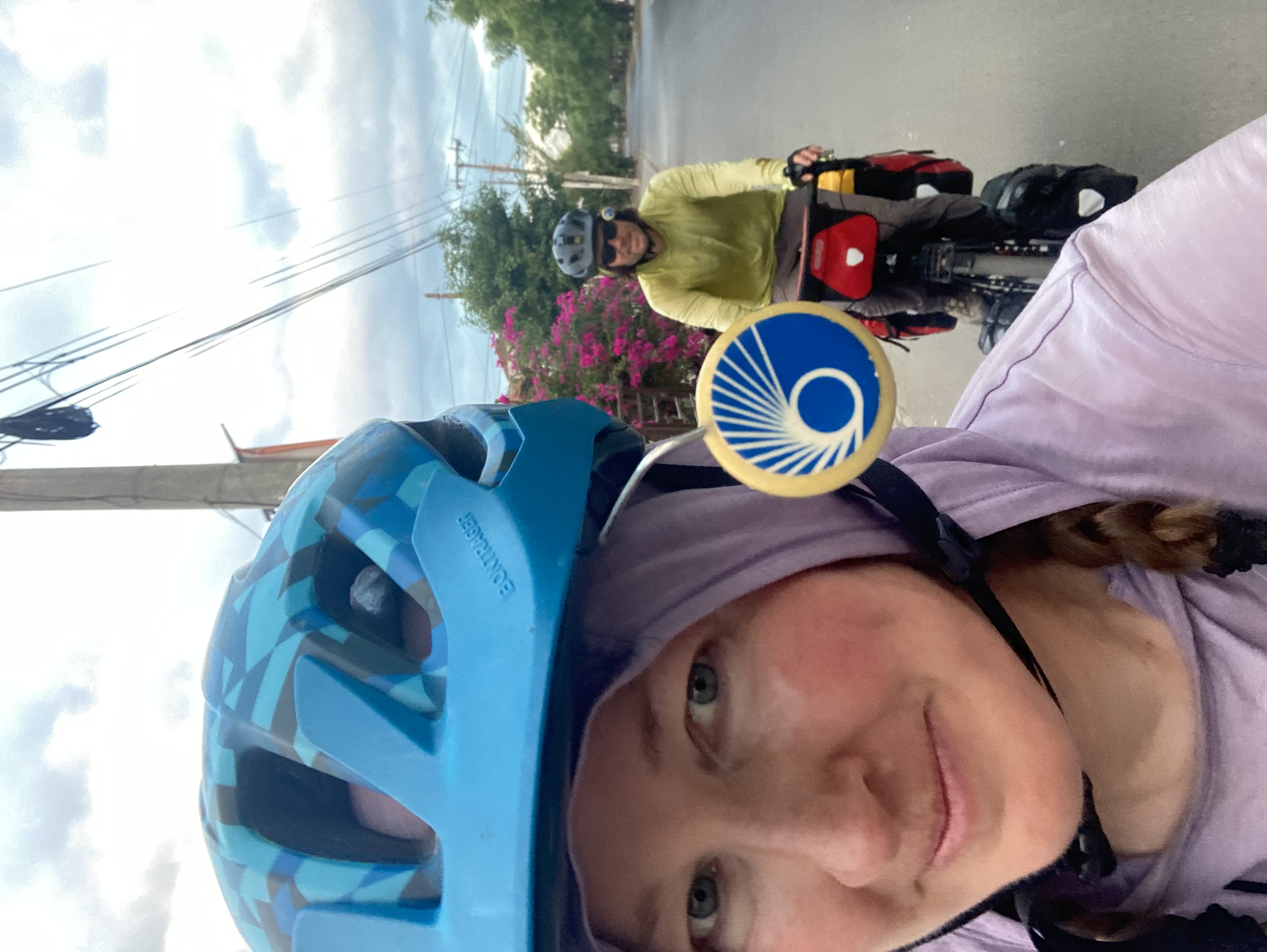
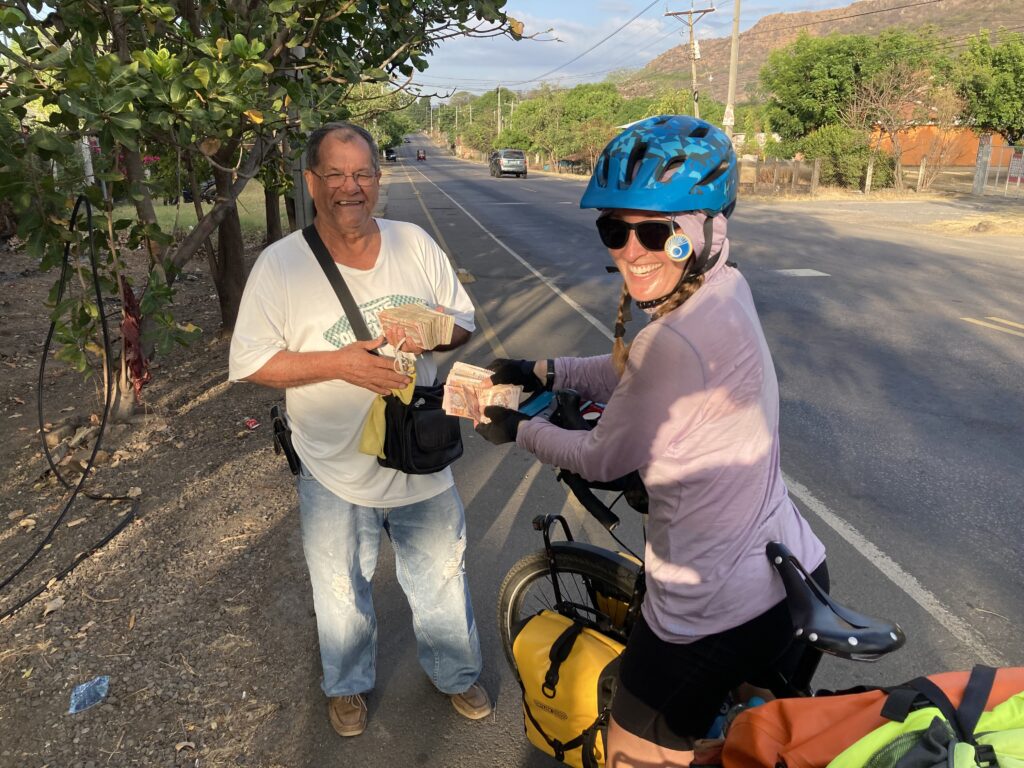
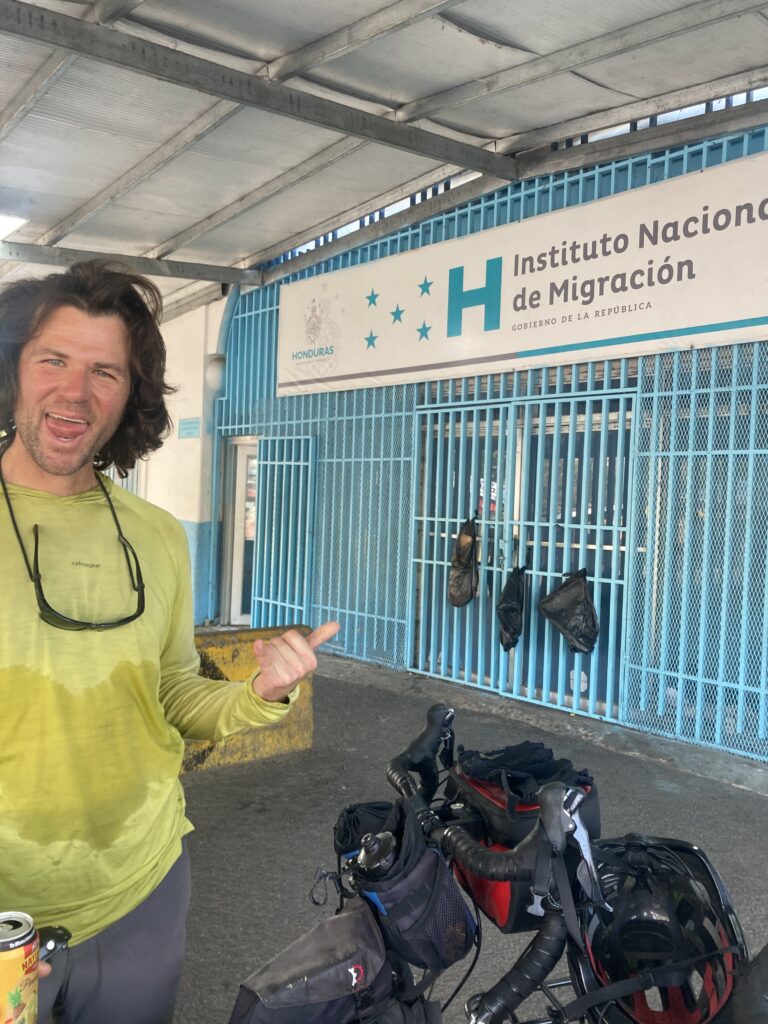

We spent very little time in Honduras, only two days biking but generally observed significantly more poverty as compared with Mexico or El Salvador. Lower quality of homes – many were constructed with sticks and mud. When we looked it up over 70% of Hondurans live in poverty with 53% living in extreme poverty. Cycling past, waving at children, and speaking with the locals we are grateful for our “birthplace lottery” and for our nurturing families who allowed us to know the freedom we currently enjoy was possible.
Nicaragua
We’d heard horror stories about crossing the border into Nicaragua – “it took 6 hours”, “they searched every single bag”, “confiscated all of my food”, “took my repair multi-tool”, etc. So when we arrived at the border we were expecting the worst but hoping for the best. We’d done our research and were prepared – Let’s go!
In the end, Nicaraguan immigration only took about 1 hour for us but was the most tedious and convoluted process, including several handwritten triplicate forms, that tested our patience. We processed through seven steps, including having to remove all of the bags from our bicycles and put them through an x-ray machine where it was uncertain whether the x-ray tech actually looked at the screen while our bags processed. Nicaragua is notoriously anti-drone and they were ensuring we did not have such equipment on us. Patricia’s binoculars received the most scrutiny – in the end it was determined said binoculars were “normalmente”.
The most important paper of the entire process was a 3″ x 3″ receipt-like “papelito” (little paper) that was used at three of the required stations and became our exit ticket. We carefully observed others and listened while a bus load of gringos was led through the process by a paid-facilitator (there were no signs). After our accomplishment in passing Nicaraguan immigration we proudly pedaled, in 102F heat, to the border town of Somotillo.
Somotillo was not the best introduction to Nicaragua – there were only two hotels in town and both had dubious reviews. We ended up at the hotel that didn’t require a bucket shower and the bicycles would fit in the room but the tradeoff was poorer quality as evidenced by our air conditioning unit (pictured below). We were exhausted and in desperate need of food – usually we can find an air-conditioned establishment but not in Somotillo – we sweat our way through dinner, went back to the hotel and were asleep by 8pm!
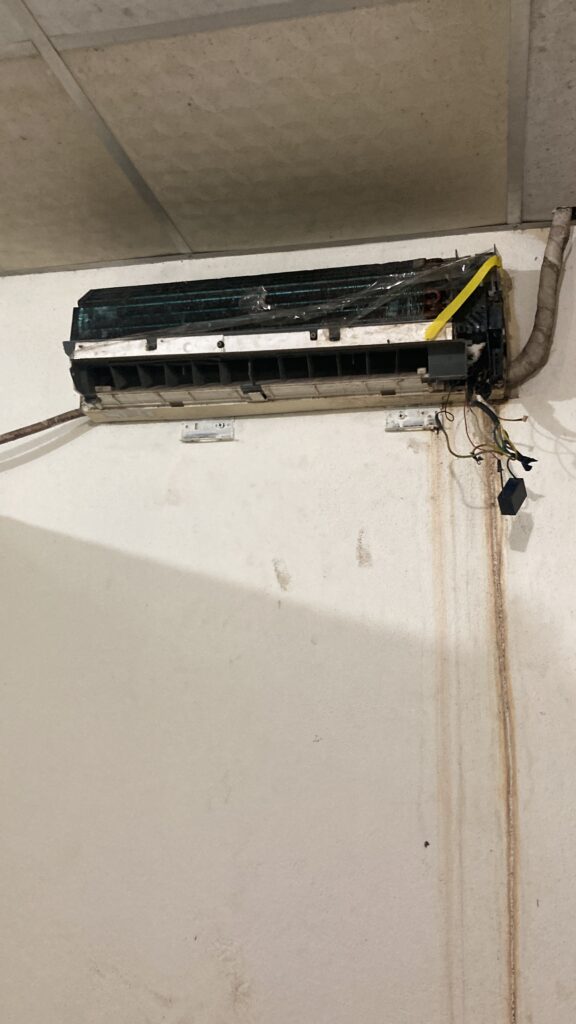
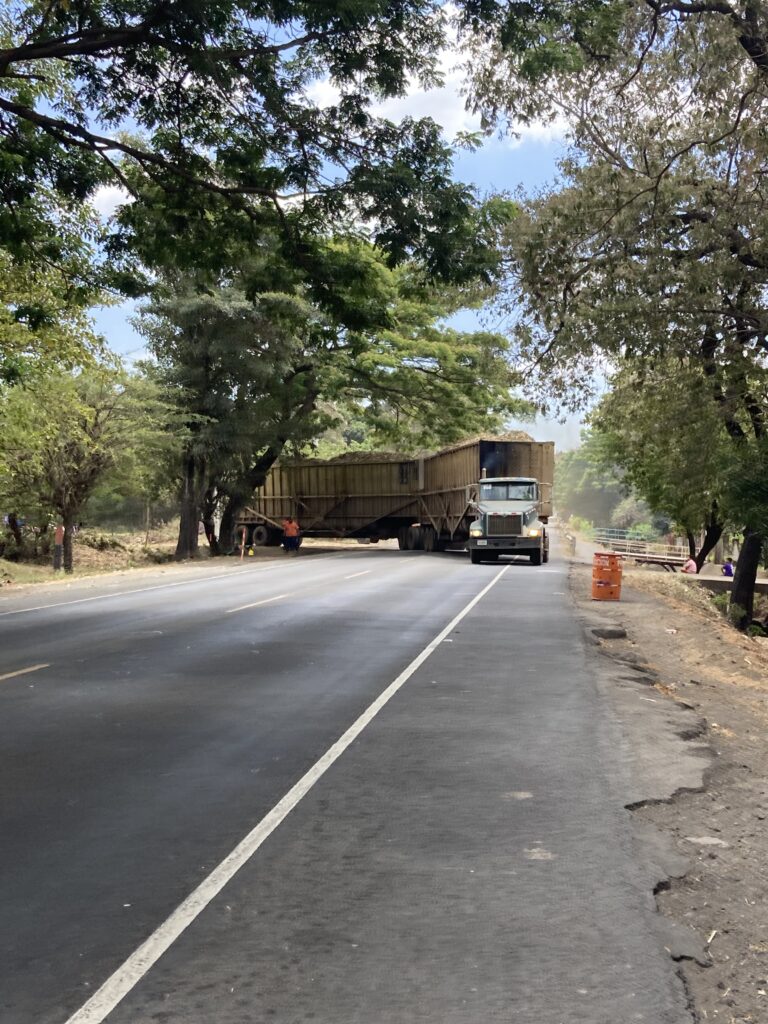
On our way to Leon, it was predicted to be quite hot again so we set the alarm for even earlier, 4am! We were pedaling by 5:40 in the morning to try and beat the heat as we had over 100k (61 miles) to ride. We pedaled around the Telica volcano which has 6 cones & is the most active volcano in Nicaragua.
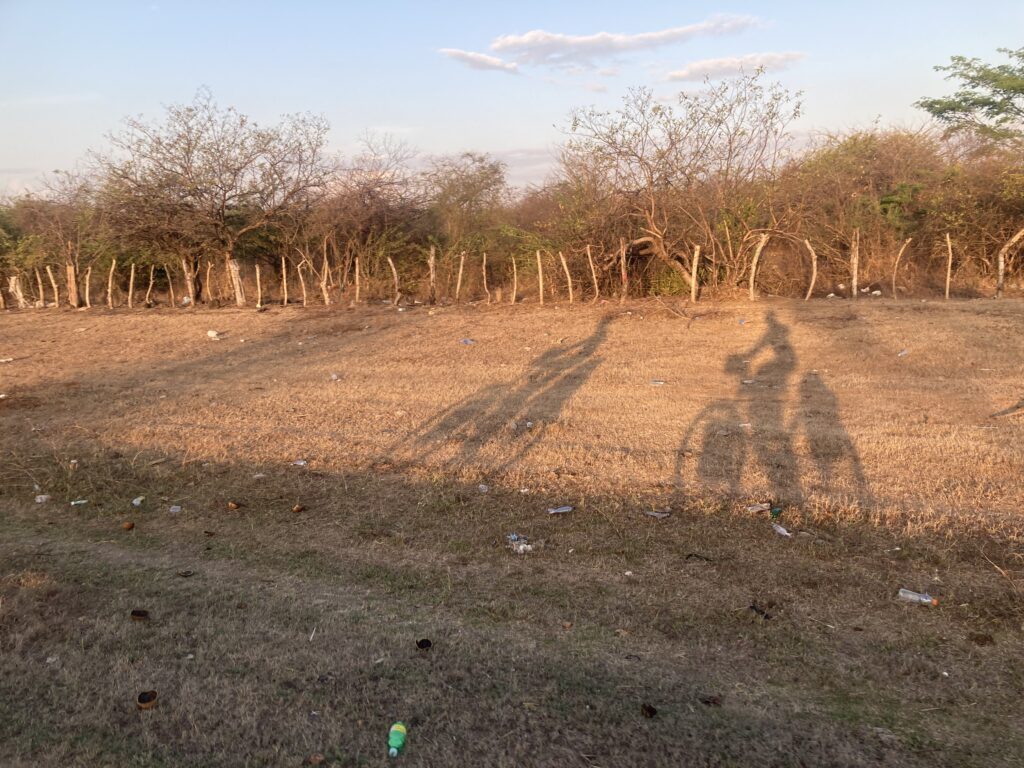
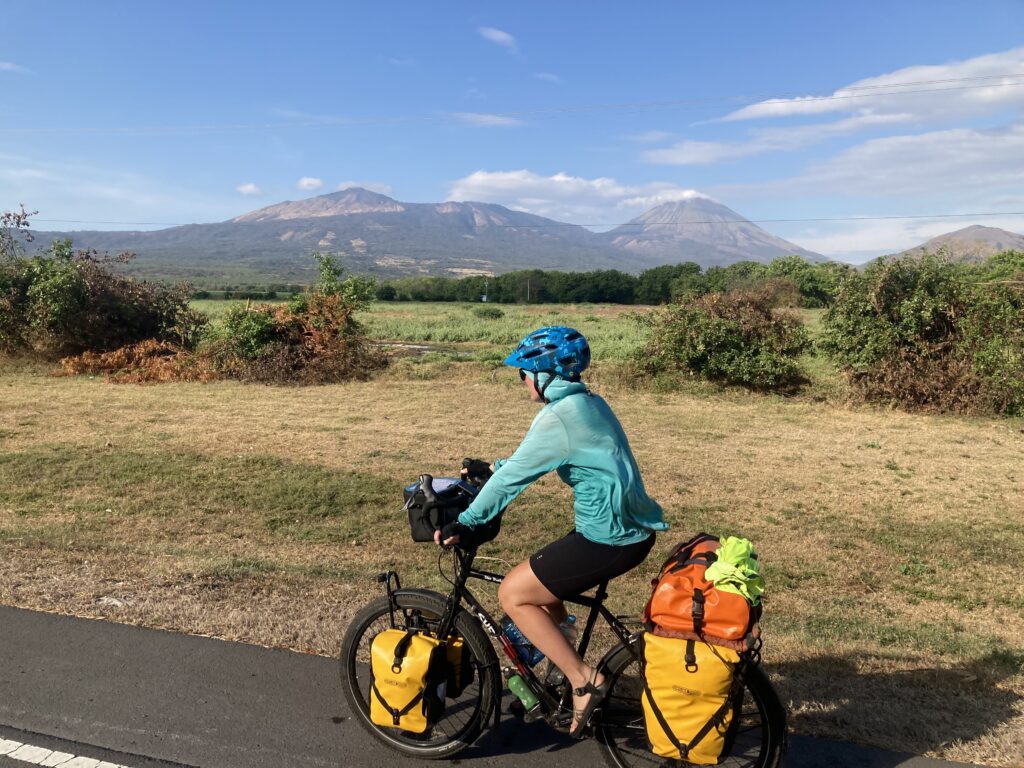
Eventually we reached Leon and were happy we had booked (air conditioned) accommodations ahead – our hostel has rooms with and without. Fellow patrons who reserved a non-air conditioned room were regretting it. Leon, Nicaragua’s second largest city, is one of the oldest cities in the Americas with a giant cathedral, the largest one in Central America. We took a “rest” day in Leon where we accomplished a lot of chores and wandered the town.

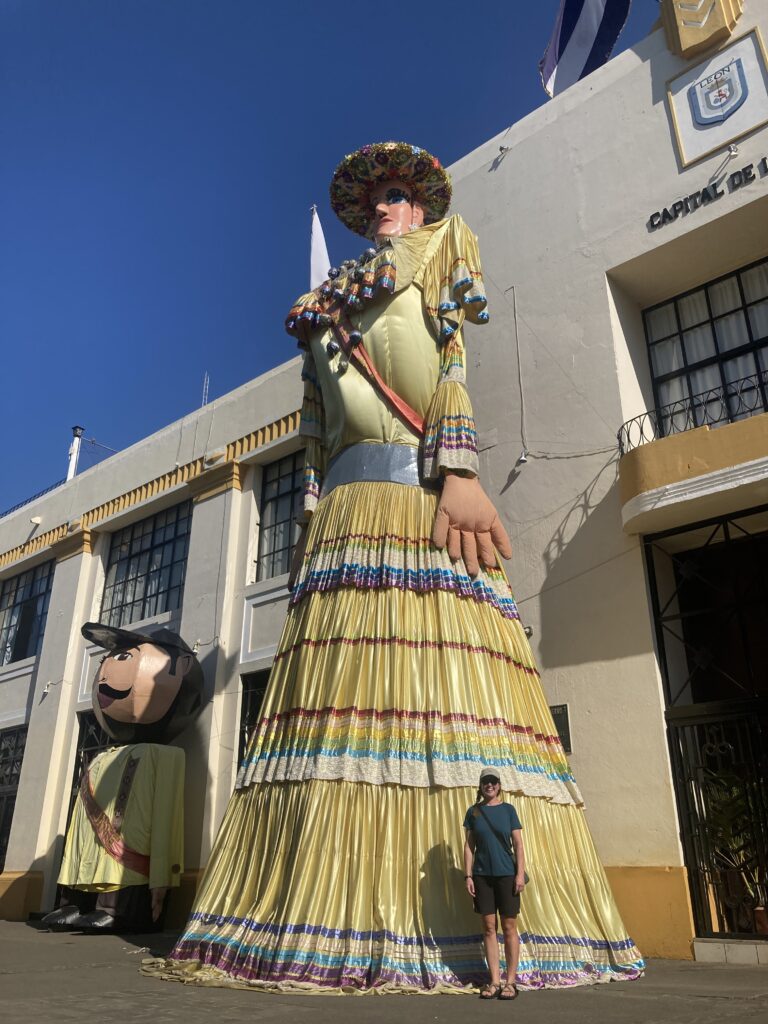

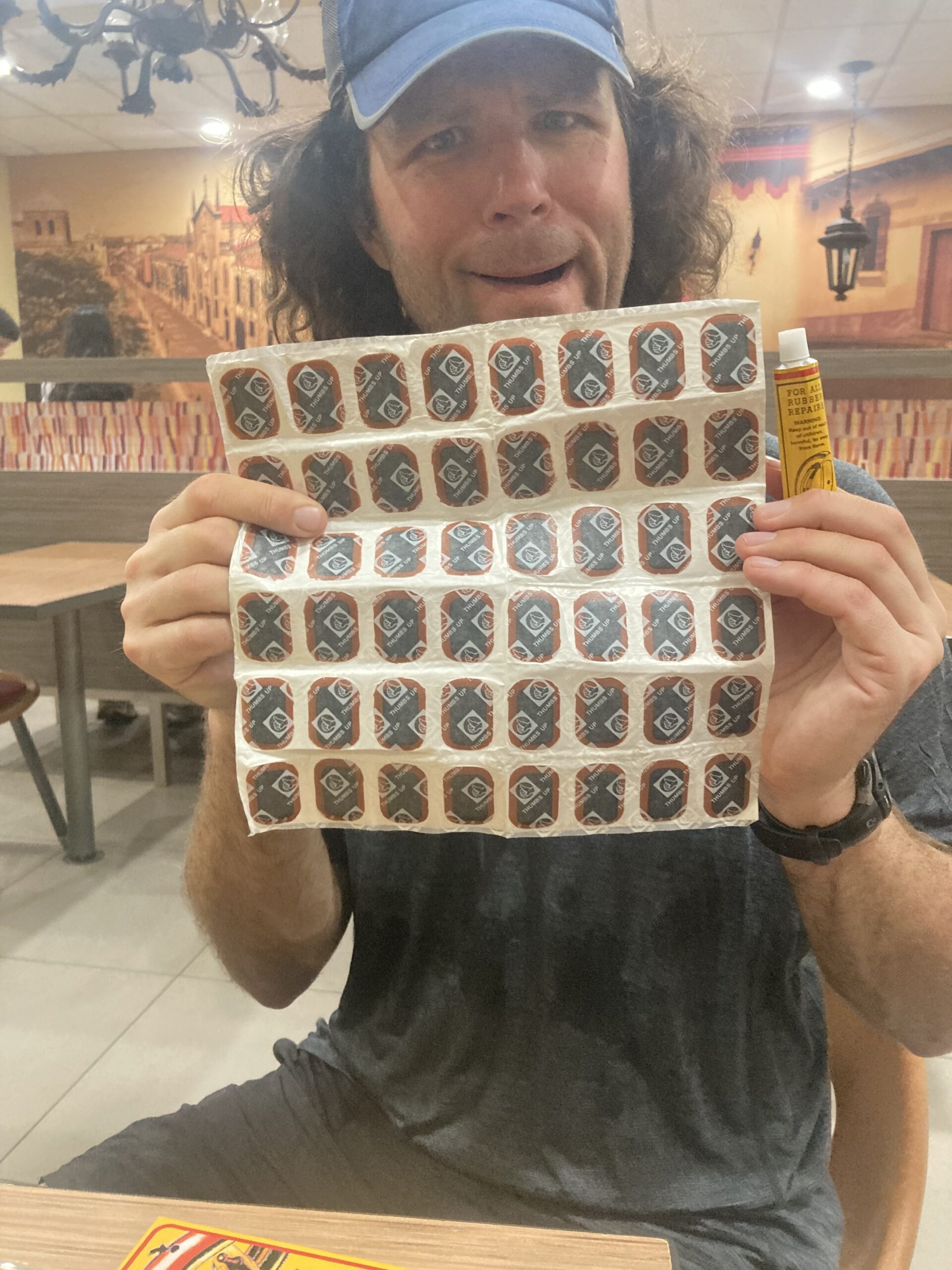
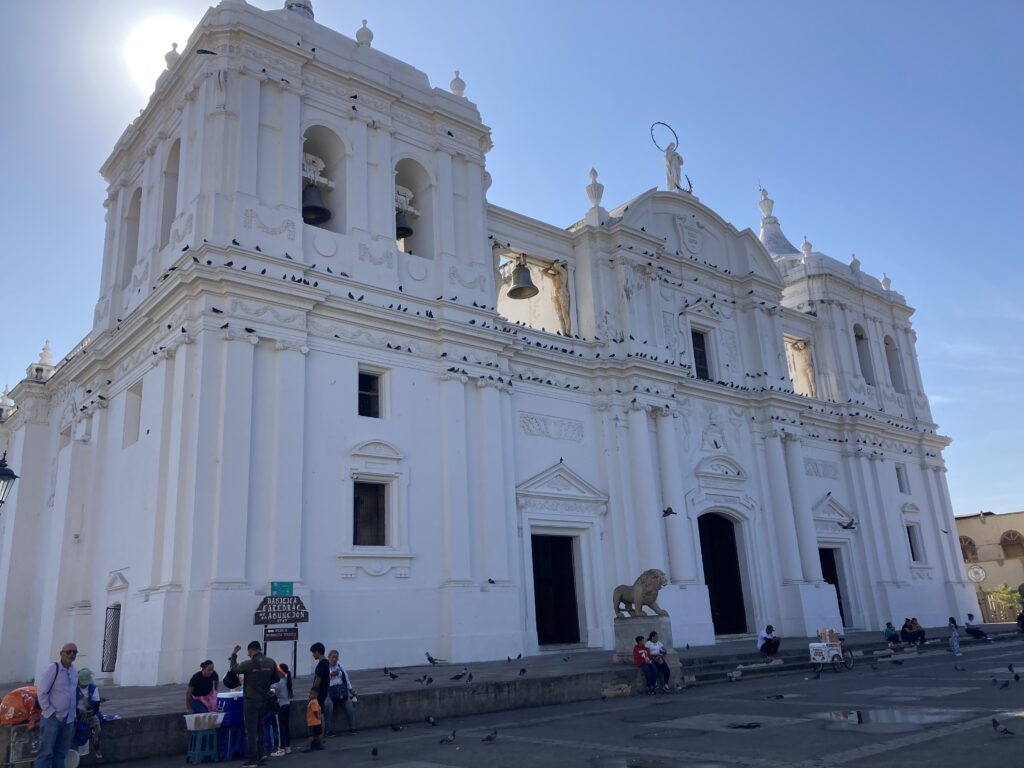
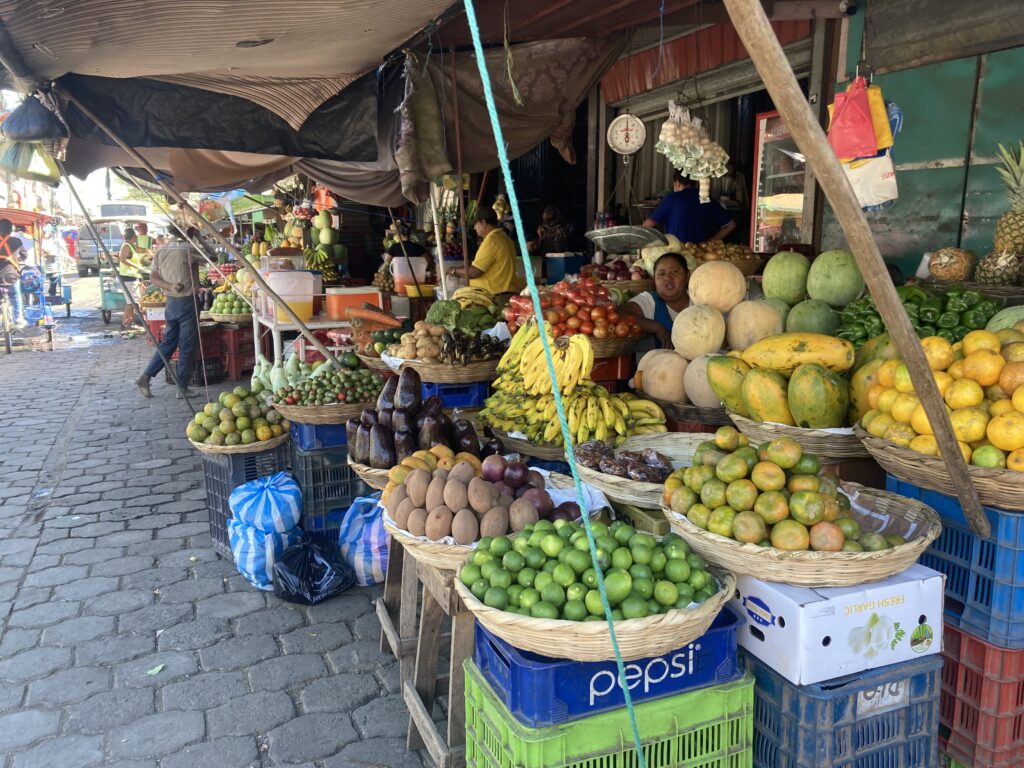
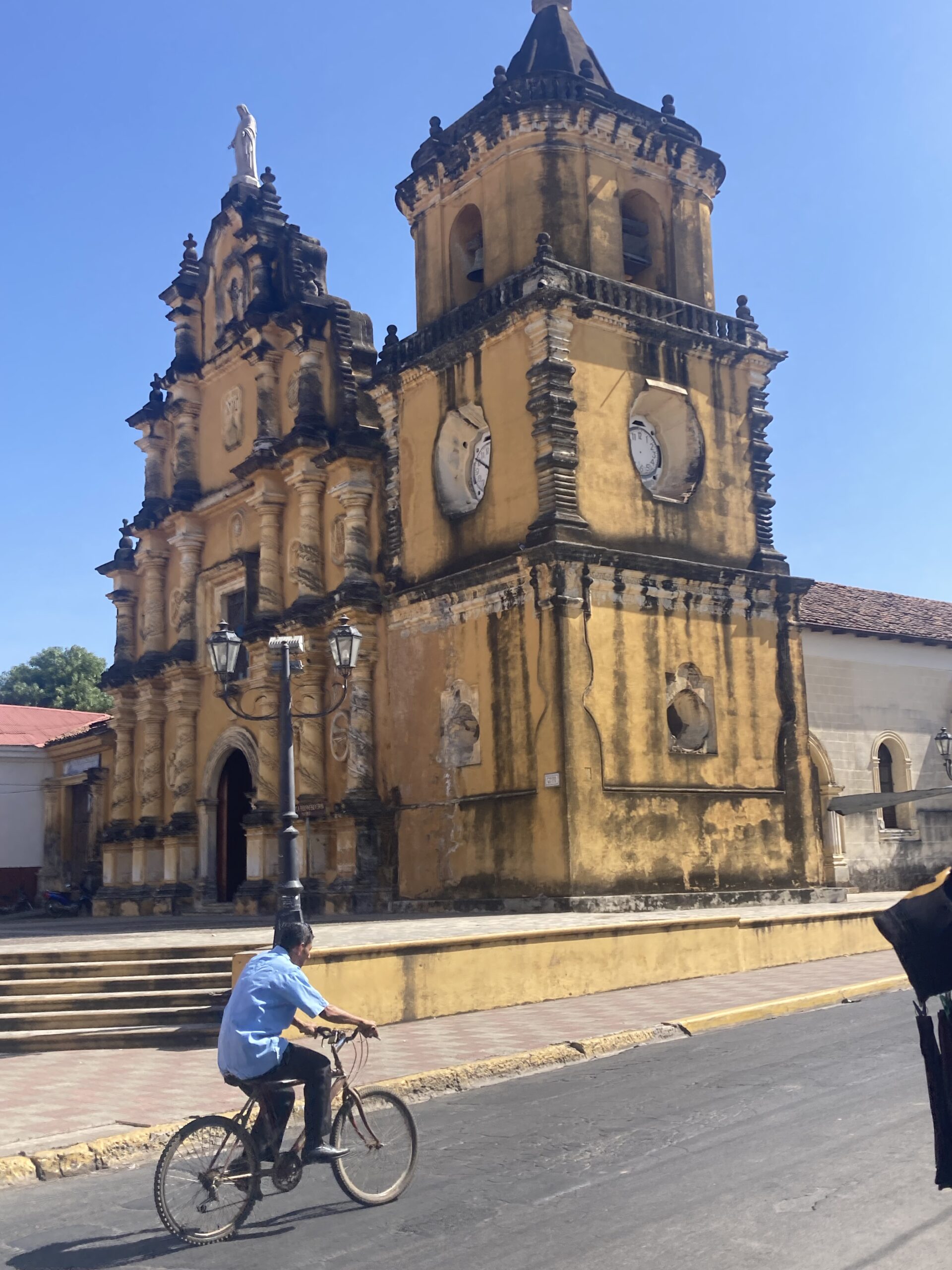

We still have four (plus or minus) days in Nicaragua before moving onto Costa Rica and then to Panama. Eventually we hope to make it past Panama City to the Atlantic coast of Panama to catch a boat around the Darien Gap – hopefully all goes as planned 🙂
**A quick note on comments…to prevent trolls & spam your first comment must be approved by us prior to appearing on the blog. After you’ve had one comment approved your future comments will automatically appear. We’re expecting to have limited connectivity for the next several days so don’t worry if you’re a first time commenter and it does not appear 🙂 **
Oh my gosh, what a wonderful travelogue through Central America. I don’t think I’ve seen that you have camped since hitting Mexico. Is it for safety, rules or heat?
The kindness of the people continues to warm me. Thanks for sharing your trip! Fondly, Lisa
Hi Lisa – your observation is correct…we haven’t camped since reaching mainland Mexico (we did camp down the Baja a bit).
Part of this is cost – hotels are more affordable. Part is secure camping is not readily available (this might change in Costa Rica). Part is safety. Air conditioning and a shower at the end of a hot & sweaty day are such a delight 🙂
Thanks for following along & commenting,
Patricia
WOW! Each blog post is so chock full of interesting tidbits. Better you than me in that heat! Heat + humidity = NO for me. Good luck as you continue on. I look forward to each blog post, living vicariously.
Hi Laura – haha, obviously the heat & humidity should be a NO for me too! Dustin is fine & I’m covered in rash!
Thanks for following along & commenting,
Patricia
Oh my goodness! One adventure after another. What you have experienced in two weeks is totally mind boggling! Thank you for sharing. I feel very happy for you when you get to enjoy good food and moderate temperatures. Rita Aksamit
Hi Rita,
Don’t worry we get good food and moderate temperatures almost every day 🙂
Thanks for following along & commenting,
Patricia
The heat and humidity is not for me. Not only did you deal with it, but you were very active in that weather. I commend you both! I’m glad your parasites are gone!
Hi Diane,
I don’t think the heat and humidity are for me either. Dustin said “How did you ever live on the coast of NC?” and my reply was…”when I lived there I didn’t bike for hours on end!”
Thanks for commenting and following along,
Patricia
Your stories about Guatemala made me happy — I love Guatemala (and Guatemalans!) … I have an old housemate who I believe is living in the Lake Atitlan area. It’s probably been 30 years since I’ve been to Lago Atitlan and San Lucas Toliman (though I’ve made other visits to more remote parts of Guatemala. I so love your reports from your trip — enjoy, and stay cool!
I am a big supporter of the round dollar and in the states I get, “are these legal,” or “will the banks take these?” Do you see any “bike paths” like we have here?
Haha @ “are these legal?” – coins last 30+ years while bills have about a 6.6 year lifespan! We need to change to $1 coins!
Sometimes, in the larger cities, we’ve had bike paths of varying quality – some are great and go on for miles while others abruptly start and stop 🙁
We try to take the bike paths when we can.
Thanks for your comment,
Patricia
What’s been the best wearing wool you’ve been using? I’ve been transitioning to merino and other wool fibers for outdoor activities, and am looking at some more summer apparel for hiking and running and whatnot.
We wear mostly Icebreaker and Smartwool for shirts. Icebreaker’s “Coolite” is my daily cycling hoodie & Smartwool’s Ultralite hoodie & t-shirts have been the most resilient. We’ve found the blends to work best as the 100% merino just doesn’t hold up.
For underwear Dustin wears Icebreaker and I wear Branwyn – they’re pricey but have held up really well, especially considering we only each have 5 pairs!
Hope that helps,
Patricia
I love all your stories and pictures. What a wonderful reminder that most people are kind all over the world. And the scenery and culture is amazing
Yes, most people are kind all over the world! Movies and media would have us believe differently…
Thank you for your comment & encouragement!
Love following along on your adventures. Glad the parasites didn’t stay for long. Keep safe and try to stay healthy. Your story reminds me that good people are everywhere.
We’re sure glad the parasites were quickly rectified also 😉
Thanks for your comment & for following along,
Patricia
It’s so much fun watching and “experiencing” your trip. Karen J. sends them to me.
Sad news for me is my husband Pastor Lee Boleman left his earthly life to be with his Lord on Jan. 31. He was an interim pastor at CLC Fairbanks. We were married for almost 68 years. I dearly miss him.
Ricky
Thanks Ricky – so sorry for your loss 🙁
Blessings,
Patricia
It was wonderful to see you both and spend some time with you!!!
Thanks for sharing your journey and all of the beautiful pictures!
Continued prayers for you. God’s Peace and Blessings
Great spending time with you too Sandy. Love you!!!
Gobbling up all your photos and stories! You have made it possible to really feel like I’m on the trip with you–and I’m loving it. Fairbanks must seem like a decade ago with all the adventures and experiences you have had. Continued blessings and prayers as your journey continues.
Marcia – thank you for your encouragement & comment. We miss Fairbanks – such a special place for us!
Fantastic photos, stories etc. Keep it up😊!
Thanks Debbie & Ron 🙂